Ptolus by Libertad!
A Player's Guide to Ptolus
Original SA post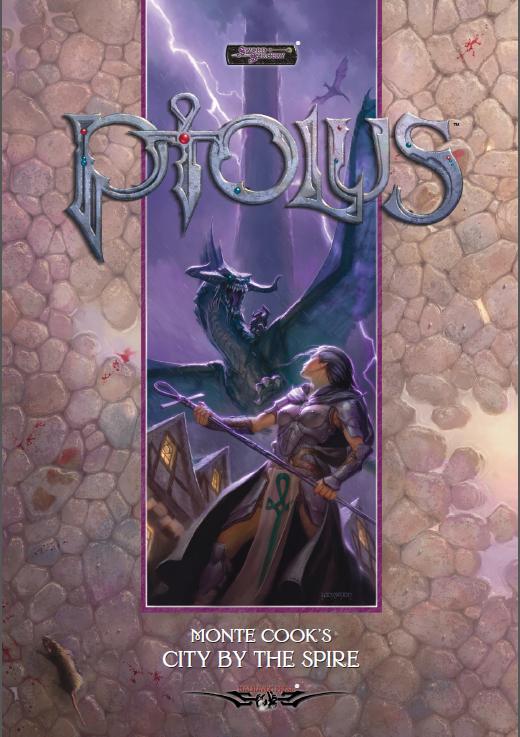
Foreward by Monte Cook posted:
This book details a place where the game’s designers, editors, creative directors, and business managers all played characters. Prowling the city’s streets you would find characters run by
the Editors-in-Chief of Dragon® and Dungeon® Magazine, the Wizards of the Coast Brand
Manager in charge of Roleplaying Games, Wizards’ RPG Design Manager and his counterpart in the
Development department, and longtime game designers and editors such as Bruce Cordell, Sean
Reynolds, Michele Carter, Andy Collins, and Sue Cook.
In other words, for years, Ptolus has been where the game’s professionals come to play. Some of the
events in this setting have passed into gaming legend, like the total party kill suffered by the Company
of the Black Lantern or Serai Lorenci’s betrayal of his entire party—or how his brother Sercian was
kidnapped and replaced by a dark elf for months of game time. Now it’s time for you to create your
own legendary stories here.
I love Ptolus. I understand Ptolus. More than any other place I’ve ever set a campaign, these city
streets seem real to me. In compiling this book, I’ve had plenty of detailed computer files and player
handouts from my home game to refer to, but I also found many cryptic notes scribbled on various
pieces of paper or alongside a map. These tidbits came to me as the city percolated in my head—the
place lived and breathed even when I had no players around my game table. I could just as easily
envision a meeting of the Council of Coin and hear their debates as I could see what the player characters
were up to in their adventures.
Far more than any notes, though, Ptolus existed in my head. I could give you a district-by-district
tour of the city, pointing out landmarks, shops, and even people on the street (by name) without ever
referring to a map or notes. In a way, Ptolus is as real to me as any city in which I’ve actually lived.
Though it can be a hard place, it’s a city I know—like a friend you like to spend time with even
though he has his faults.
I love Ptolus. I hope that you and all the people around your game table will grow to love it too.
Moreover, I hope that my own personal affection for the city comes through as you read this book.
The material in these chapters is tested and true, played by real gamers with a love of the game. As I
ran my campaigns set in Ptolus (as of this writing, there have been three, plus the predecessor Praemal
Campaign), I encountered the same issues that all DMs come upon. Hopefully my experiences with
them will make game play easier for you.
What is Ptolus? Imagine a cosmopolitan fantasy city where humans, elves, and dwarves rub
elbows with orcs, ratmen, and stranger creatures. A city built upon the ruins of two previous settlements,
creating a mazelike undercity full of dangerous (but lucrative) chambers just waiting to be
discovered. A frontier port ruled by a power-mad theocracy amid the decay of a collapsing Empire.
A place where crime families war openly and noble houses battle discreetly—with equally deadly
results. A city where magic is familiar, adventurers are welcome, and thousands of residents dwell
beneath the shadow of a Spire crowned with a citadel of evil so strong that the very earth thrust it
away from itself untold ages ago.
Welcome to Ptolus.
Monte Cook
Ptolus is a campaign setting first released in 2006, but its origins are far older. Turn the clock back to the late 90s, when Wizards of the Coast was but a card company. Flush with success from their Magic: the Gathering franchise, Wizards bought the rights to Dungeons & Dragons from TSR, by then a dying beast whose poor business decisions nearly bankrupted the company. Monte Cook, who worked on Planescape in the past, set out with a bunch of other employees to work on a new 3rd Edition of the world's most popular table-top role-playing game.
To iron out the kinks, play-testing sessions were performed in a setting of Monte's own design. It was a sprawling metropolis situated over a vast complex of dungeons which had swallowed up countless would-be adventurers over the years. Over time it grew into a full-fledged world of its own. Ptolus, the City by the Spire.
This product is primarily a city setting for 3rd Edition Dungeons & Dragons. What's unique about it is that due to its origins it fits D20 like a glove. Remember all those 3rd Party conversions to the D20 system, and of shorehorned mechanics from earlier Edition settings being warped and twisted to fit the current rules? Well the reverse is true in Ptolus, for it is the "D20 Fantasy in microcosm," as Monte Cook puts it. It is a world where there are shops catering to adventurers and are more than eager to buy their loot, a world where law enforcement employs See Invisibility and Zone of Truth to deter crime, a world where even if less than one in a hundred people are spellcasters, the average citizen sees the works of magic on a regular basis in some shape or form.
And it works. Many of 3rd Edition's problems are still present, but the book itself takes a lot of the tropes into account. I feel that it hasn't succeeded completely in this case, but I'll talk more about it as we go along.
For this review, there is a lot of bonus content beyond just the book. Whether you bought this book in the original print run or on Drive-Thru RPG, the core book comes with a bonus adventure, the Night of Dissolution; two other complete sourcebooks, the Banewarrens (an adventure) and Chaositech (evil Lovecraftian technology); Monte Cook's very own campaign journals; Issue #1 of a comic tie-in to the setting; and printable versions of player handouts. Now I'm definitely going to be reviewing Night of Dissolution and the comic, but I feel that Banewarrens and Chaositech are distant enough in that they might best be served as their own reviews even if they tie in to the setting itself.
Chapter 1: A Player's Guide to Ptolus
This is available as a free 32-page guide online, and 5 copies were sold with the main book in the original print run. It is basically a short introduction to the setting, meant to be shown to players with just enough history and explanation to give them a feel for Ptolus.
So, what is Ptolus? Well, it's a teaming metropolis in the world of Praemal at the edge of the very old and venerable empire of Tarsis. Three emperors have legitimate claim to the throne, and many feel that the best is behind them and feel uncertain about their future. But in Ptolus these effects feel distant at best. It is a trade haven for all sorts of folk of varying races, cultures, and magical practices and religious beliefs. When the first "delvers" returned from the catacombs below the city with gold and magical treasures, a renewed interest in the city came as hundreds of adventurers pour past its walls each month. Most never strike it rich, much less survive the treacherous underground realms, but the dream of wealth and glory still persists. Many theorize that these dark reaches date back to the olden days when the Skull-King Ghul ruled over the land, his fell armies living among the warrens and winding tunnels beneath the earth. In the shadow of an unnaturally tall spire arose a whole form of politics, economics, and social structure was born. For some reason great creatures of good and evil have been drawn to the area, and the influx of adventurers prompted renewed devotion to science, magic, and religion.
Ptolus is a port city of 75,000 people, ruled by Commissar Igor Urnst, a decorated war hero and representative of the Empire of Tarsis. It has a sizable human presence, but all manner of races comprise a non-neglible portion of citizens. Council members, who represent influential industries and demographics, play a role in the city's policies as well. His influence does not extend into "the Dungeon," which is a catch-all name for the many reaches below the city, and the City Watch. The city watch itself is mostly composed of armed men and women, with a few elite members (several dozen) trained in magic and advanced fighting techniques. The Sisters of Silence are an unofficial keeper of the peace, an order of mute female monks who apprehend criminals and have male eunuchs speak on their behalf.
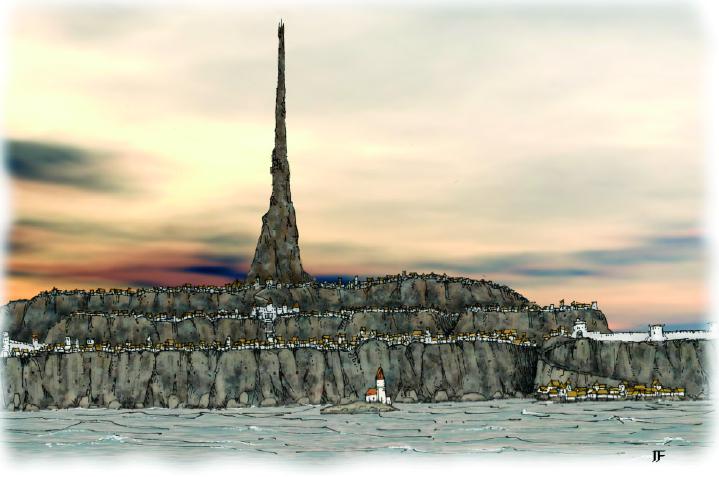
The city is into eleven official districts:
The Docks, center of sailors and seabound trade.
The Guildsman District, home to the artisans, builders, and many workhouses of the city.
Midtown, a commercial and residential hub home to many taverns and inns, and also houses the famous Delver's Square, a neighborhood built above an underground entrance which caters to the needs of adventurers.
The Necropolis, a massive walled cemetery home to undead and heavily guarded by watchmen on the outskirts.
The Noble's Quarter, home to Ptolus' greatest noble families and the wealthiest (and most well-guarded) section of town; it is closest to the spire and residents who "don't look the part" aren't allowed beyond the district's gates unless they have official business.
The North Market, home to many great eateries and various small shops.
Oldtown, originally built around the fortress of Dalengard which fought against the evil forces of Ghul and other malevolent forces. It is now the center of the city's government, and it is here citizens go to obtain licenses, conduct trials, and other bureaucratic business.
Rivergate, a middle-class neighborhood whose residential cul-de-sacs called "burroughs" each sport their own cultural and architectural influences.
The South Market, home to the headquarters of Ptolus' largest merchant companies and a residential district for business owners.
Ptolus is a city unique for its religious freedom, and the Temple District is the center of religious life in the city. Areas of worship, ranging from grand cathedrals to small roadside shrines, abound here, honoring hundreds of different gods and goddesses.
The Warrens is a crime-ridden slum home to the poorest of the poor of Ptolus. The city watch does not venture inside except in droves and only to apprehend serious criminals. The various crime families and gangs dominate daily life here as the neighborhood's unofficial rulers.
The Undercity Market is not a district of Ptolus per se, but it is a bustling place to go for most adventuring gear. Accessed via a set of stairs in Delver's Square, a bunch of adventurers converted a section of the Dungeon close to the surface into a marketplace and headquarters. People post hiring notices for adventurers and treasure for sale on public boards, while many businesses make a steady living selling maps, reference material, survival gear, and similar goods.
We also have a bunch of other material in this chapter, but I feel that it can safely be referenced later.
In regards to the world beyond Ptolus, two moons orbit the world. Most people known that Praemal is round, and that it orbits the sun. The existence of the Ethereal Plane (called the Etheral Sea) is also common knowledge, as well as names of the elemental planes, but only in so far as they are "adjacent" realms to their own world. Nobody knows much about the upper planes (referred to by various names such as the Celestial Realms, the Heavens, etc), other than that they're inhabited by angels and other exemplars of Good. Same for the lower planes, or just simply "the Hells." Of interesting note is that nobody in recorded history has managed to travel beyond the Ethereal Planes, only going by the knowledge given to them by celestials, fiends, and summoned monsters.
The Empire of Tarsis encompasses much of the known world. It is technically shared by two Emperors, a temporal one (the Emperor) and a spiritual one (the Holy Emperor). Originally the spot was held by one, but a brother who ascended to the throne abdicated responsibilities to the high priest of the Church of Lothian (the state religion of the Empire and most popular deity in Ptolus). Over time the two offices developed into their own branches of government. The Holy Emperor has his own army, his own treasury, and can sign and pass laws (although they're required to be pertaining to spiritual matters).
Tarsis was founded by an alliance of folk, from humans to dwarves, fighting against the Skull-Lord Ghul and his forces of monsters, demons, and other evil things. When the Prustan forces from the city of Tarsis ventured west to help defeat him, they stayed in the area, hoping to rebuild order. The folk of the west welcomed their arrival, and along with the dwarves, brought advanced science with them. Firearms, clockwork machines, and even steam-powered engines and printing presses! Roads, waterways, postal services, and well-ordered public planning help increase the standard of living in these realms, leading to Tarsis' ascension as a dominant political power. For a time, life was good, but over the years the Empire became increasingly draconian. Certain people who by unfortunate circumstance were declared noncitizens and formed a large disenfranchised class. The Church of Lothian cracked down on other religions, and ultimately arcane magic was outlawed as a "demonic influence" in the Edict of Deviltry. Church and state over time became one, and Tarsis continued expanding.
However, it is now a shadow of its former glory. In the last two hundred years education worsened and knowledge of building the complex scientific devices became increasingly forgotten. The Edict of Deviltry was overturned, and the weakening of the government's power resulted in political divisions. Other religions practiced fairly openly when the Church became not powerful enough to stop them.
Next part is a general overview of the races of Ptolus:
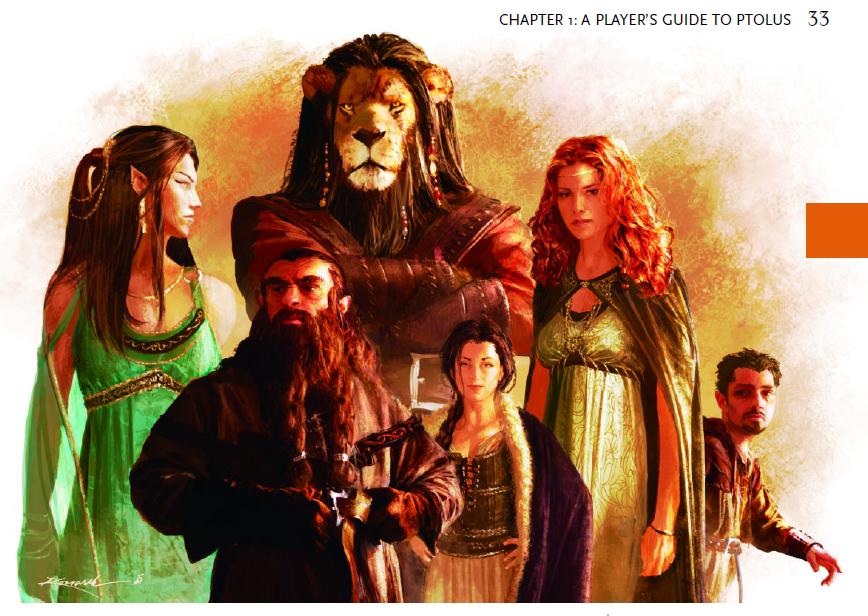
We have the standard Player's Handbook races, but of note are some additional options. We have the proud Litorians, lion-people. The Aram, or nomadic centaurs. The Assarai, or Lizardfolk, who live poor yet content existence as homeless wanderers. The Harrow Elves, elves tortured and warped in the dungeons of Ghul and forced to carry curses through their bloodlines. And the aloof Cherubim Elves, winged elves from the mountains to the west. There are other races present, from orcs to tieflings, who are more or less allowed to be in Ptolus' walls. Except for drow, as it is against the law to be a dark elf within the city's walls (punishment is death).
We get a section labelled PC Backgrounds for long-time residents of Ptolus. Basically they are short descriptions to help tie your character to the city. They grant mechanical bonuses and are available based upon your resident district. They mostly grant bonuses to skills, but a few grant special contacts among your neighborhood and/or occupation. Here's a list of them below:
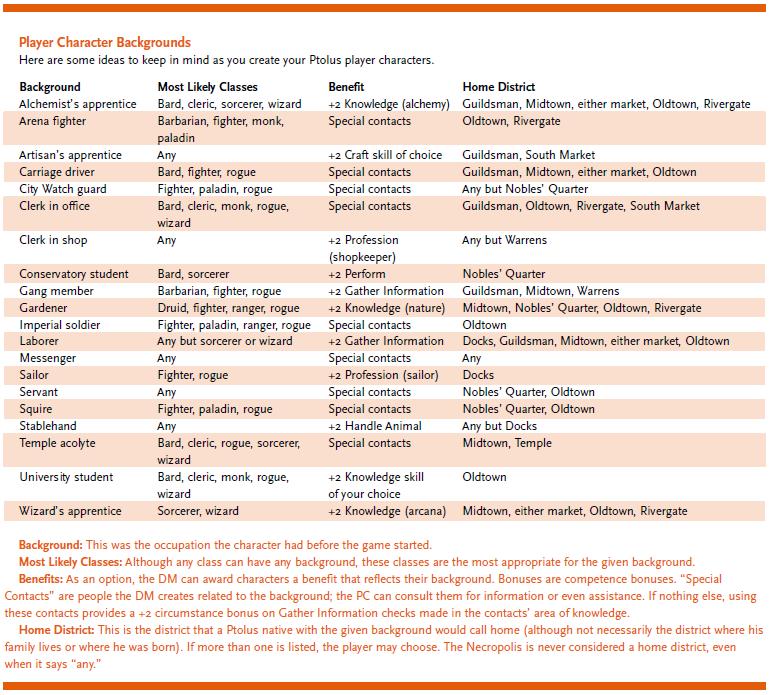
Alchemist's Appentice is a typo, as Alchemy is a Craft skill, not a Knowledge one.
Also, fun Ptolus facts!
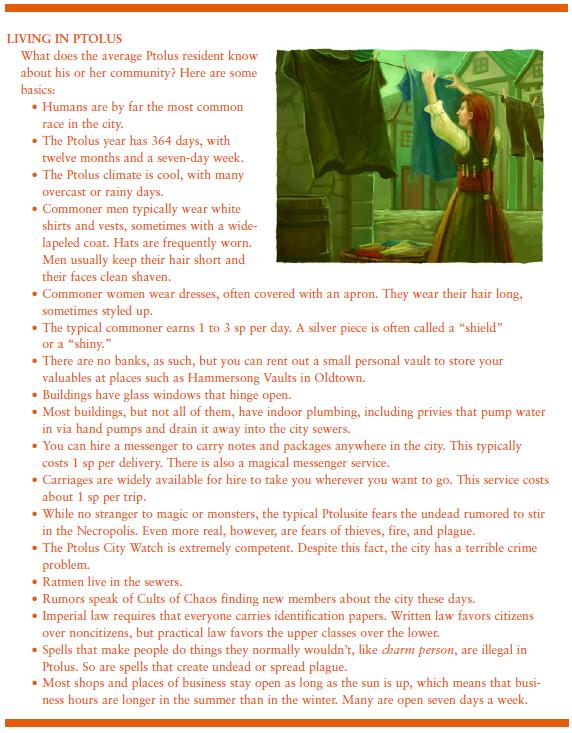
We also get brief description on how each of the character classes fit into Ptolus, and mentions of prominent organizations in the city pertaining to related fields. Overall the city is home to most classes, although Druids are not very common, and most Barbarians in the Empire are human invaders from the east. Many among the monk class are treated as religious figures in various religions, and as such can be found attending to spiritual matters in temples, too.
Magic is very common, but it remains out of reach of the common man, and magic item shops overall are a small group. Sellers of potions and minor items can be found in the Undercity Market, while Myraeth's Oddities is a well-guarded and warded shop which buys and sells magical items. Those seeking powerful, custom-made permanent items are advised to contact the Dreaming Apothecary, a shadowy group of mages who do business in the client's very dreams. But beginning low-level PCs don't know how to contact them; they don't sell to just anyone.
As expected, Ptolus operates on a generally higher technology level, and primitive firearms can be purchased by PCs with a license. However, advanced technology is becoming increasingly rare in the world as the knowledge to create and maintain them shrinks year by year. Spyglasses, pocketwatches, printing presses, hot air balloons, spectacles, and powder bombs are the most often seen pieces of technology in Ptolus.
Thoughts so far: This provides a short, if useful guide for players beginning a campaign set in Ptolus. Its flaws are that it doesn't show much of the beauty and uniqueness of the setting, which is further into the chapters. However, in this section and throughout this book are helpful side-bars which function as a kind of index, telling you what page which relevant information is on. If a major NPC is mentioned in an adventure or city district chapter, you'll get the page number for him and his stat block on the side. Same for organizations, historical events, locations, and similar things. It makes the book and PDF very user-friendly to navigate.
Next time, Part 2: the World! Where we get additional details on the setting and its history!
The World
Original SA post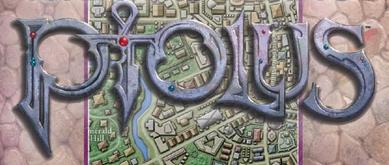
Chapter Two: The World
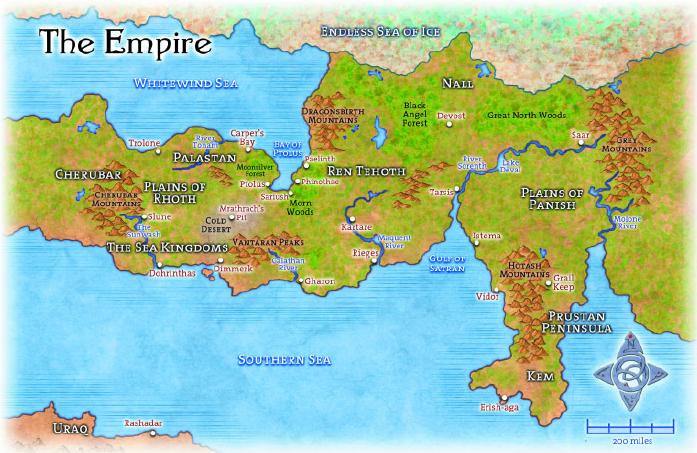

The world of Praemal is round, slightly smaller than our own Earth. Traditionally three moons hung in the sky, Lunas, Rogue, and Vallis. But ten thousand years ago Vallis disappeared, changing the way magic worked in this world forever. In the sidebar Monte Cook had its disappearance signal the change from 2nd to 3rd Edition in his own Praemal campaign. Which, judging by the game mechanics, should mean that primary spellcasters will be entering a new golden age of unsurpassed power. Cook also hints that if the moon should ever return, then great changes will surely happen again. And what would you know, the supplemental adventure that comes with this book is all about this!
Gazetteer
Here we have a brief description of the known nations of Praemal. Ptolus is technically in the nation of Palastan, but it's maintained independence from its monarchy.
Cherubar is a mountainous country to the west of Ptolus, populated by winged Cherubim elves and a few human settlements, both battling against savage hordes of giants who continually enroach upon their territory. It is rumored that the ancestry of air elementals flows in these peoples' veins.
The Cold Desert is an inhospitable and barren region to the southwest of Ptolus, home to orcs, hobgoblins, and other evil humanoids.
The Eastern Hordes are a unified confederation of tribes to the east of the Gray Mountains who invaded the Empire in recent years. Led by King Oulgas, they ovewhelmed the fractured imperial forces and conquered the capital city of Tarsis itself. But the barbarian leader had nothing but contempt and spite for the people of the west, and in four years he led his forces back over the mountains. When asked why he went to war in the first place, he answered "because I could."
Kem used to be a nation of great arcane might, but vast amounts of powerful sorcery in civil wars laid waste to the region, tainting its soil and destroying entire cities. Only the toughest animal and plant life can survive in this inhospitable region, and the remnants of civilization build upon the ruins of tors (rocky hills).
Nall is an icy northern nation believed to be the birthplace of humanity. Its folk are a hardy lot, living in nomadic tribes usually ruled by female spellcasters. Long, harsh winters result in very isolated settlements which can go years without meeting each other.
Palastan is a fertile land with beautiful hills and great green forests. In the last year the Imperial Governor was killed during the rioting and upheaval in the capital city of Trolene. The original King and Queen of the country, along with their monarchist allies, seized the seat of power and took control of the nation "until Tarsis appoints a new governor." The Empire, meanwhile, has its own concerns to attend to and cannot quell this usurpation of power anytime soon. The city of Ptolus is technically within Palastan's borders, but it has maintained independence from the new monarchy. Also, a powerful circle of rangers and druids known as the Viridian Lords hold powerful sway in this land, operating independently from the government and communities often turn to them for guidance. They also help drive off monster and bandit attacks in the rural regions.
The Plains of Panish are seemingly endless miles of flat grassland east of Tarsis, home to many primitive tribes of humans, centaurs, and litorians.
The Prustan Peninsula is home to the Prustan people and the Grailwarden dwarves. The Prustans took over the lands around Tarsis about a thousand years ago, eventually leading to the rise of the Empire. They are an industrious people with an extensive societal infrastructure, and they and the dwarves have been allies as long as either could remember. Due to their prominence, Prustan humans are found in lands throughout the Empire.
The realm of Ren Tehoth was in decline long before even the Empire of Tarsis rose. Its dwindling nobility and shrinking population gave rise to many ruins. Frightened by Tarsis' increasing power and desire to avoid war, they accepted foreign rule with little bloodshed. Today the land is home to many prominent elven cities, who have much in common with their western brethren except that they're less comfortable around humans.
Rhoth is a rural nation of plains to the west of Ptolus, home to small towns and villages frequented by halfling caravans. They are a hearty, if xenophobic, folk, and thirty years ago they had a terrible war with the gnoll tribes in the area; the events are still well-remembered to this day.
Sea Kingdoms and Dohrinthas are a federation on the southern end of the continent of once-warring pirate states. It is a very rich region, blessed with heavy trade by land and sea, and little warfare has despoiled its economy. When massing barbarians threatened Tarsis in 706 IA (Imperial Age), Empress Addares XXXIV moved the capital from Tarsis to Dohrinthas. This resulted in splitting the empire, as the aging councilor Segaci Fellisti held the throne in Tarsis before it got sacked a few years later.
Tarsis is the capital city of the Empire which rules over little more than half the world. It is still recovering from the barbarian invasion of a decade ago; toppled walls are being rebuilt, and refugees are slowly returning. The Grand Cathedral serves as the headquarters of the Church of Lothian, despite the fact that the Emperor of the Church remains in the city of Ptolus. At its height, the Empire encompassed the entire Prustan Peninsula, the lands surrounding the southern sea including Uraq, and the northern lands of Cherubar to the Grey Mountains. Now its grip is shrinking, and some feel that the empire has fallen. But just as many folk proud of their Empire, and pay just as much fealty to the two Emperors.
Uraq and the distant South held sway over most of the known world before the rise of Tarsis. They controlled the Southern Sea as the dominant seafaring power, but those days are long past. They fell five centuries ago in bloody wars to Tarsis, but over time the Empire has proven tolerable rulers. The arid climate has never held much appeal to the Prust, and the hot desert sands were a constant hindrance to maintenance of their guns and machines. There are more lands farther to the south, including the realms of Panogolan Bunneir, lands of savanna and jungle ignored by the Empire. Beyond is the empire of Kellisan at the World's End Sea. Most folk of the Empire think of all lands south of Uraq as simply "the distant South" and know no details of such places.
Interesting Sidebar Notes: In the world at large there are no "dungeons" to explore. An adventurer is not a respectable or valid occupation, and in the Empire the worship of Lothian is predominant in overwhelming numbers. To others, Ptolusites have a rather casual attitude to danger, evil, and general weirdness.
Also, evil is not just an alignment and a real palpable thing, it has physical long-term effects on the land itself. Heavy use of black magic (evil spells, powers which destroy souls, create undead, draw upon negative energy, summon fiends, et cetera) cannot be used without contributed to a lingering taint which can spread across the land. Several areas in Ptolus stand as proof to this: the Dark Reliquary, Ghul's ancient fortress, and Jabel Shammar (the fortress perched on the top of the Spire) are so steeped in evil that the places themselves have become malign. In Jabel Shammar's case it was so bad that the earth itself pushed the place away from it, culminating in the 2,000+ foot tall spire the city of Ptolus is built around.
Languages
Now we get the languages of Praemal.
Abyssal is spoken by all lower planes fiends (there is no Infernal). Thousands of years ago the Dread One Eslathagos Malkith adopted the language and taught it to his creations, explaining why its common among aberrations and many other beings.
Charad was spoken by the Charad Titans who visited the Whitewind Sea 6 millenia ago. It is own only to a handful of elven scholars.
Common, also known as Imperial, is a newer version of the Prustan language which came about with the expansion of the Empire of Tarsis. Currently it serves as a useful trade tongue and is the national language of the Empire.
Draconic is one of the oldest languages, up there with Elder Elvish and Dwarvish. Many magical writings are Draconic.
Dwarvish remained virtually unchanged for thousands of years, and most words are short. The language makes heavy use of compound word constructions to create new words as needed.
Elvish is a newer version of Elder Elvish. It is a lyrical, beautfiul language with a huge and very precise vocabulary. It also grants speakers a +1 bonus to Diplomacy checks when they converse with others in the language, as politefulness and tact are heavily built into it. You can still insult someone, it just requires more thought and effort.
Dark Elvish also derives from Elder Elvish, with many words for darkness, betrayal, and similar concepts, but none for charity or mercy.
Elder Elvish is a dead language with virtually nobody speaks anymore. Its letters double as numbers, which makes it very easy to craft codes and double meanings with it.
Gnomish also derives from Elder Elvish. So does Halfling, which also borrows a lot of words and phrases from the human language of Westron.
Litorian is a gruff language spoken by the race of the same name, and is unrelated to any other language in the world.
Old Prustan is a human language which sounds hard gruff. Today only a few scholars speak it. Old Prustan is based upon real-world German, and thus many human names in Ptolus sound a lot like German, Austrian, and Prussian ones.
Orcish is a mixture of Abyssal and Westron. Originally the orcs spoke Abyssal, taught to them by the Dread One. After his destruction they fled west and picked up many human tongues in their new homes.
Palastani is a rather simple language which is coming back into vogue after the nation's monarchy returned.
Nallish is spoken by the people of Nall and the barbarian tribes of the east.
Undercommon derives from Elder Elvish mixed with some Abyssal and Draconic. Originally the dark elves spoke it, but it spread across the underground realms along with their prominence in those lands.
Uraqi is a human tongue which originated in Kellistan far to the south. It has no clear visible relations to the other human tongues.
Westron is believed to be the oldest human language, but few know its true source. Some believe that it was a "Common" tongue of pre-Imperial days, while others believe that it was taught to humans by the Creator himself.
Special Materials
In addition to the common components of darkwood, mithral, and similar materials for 3rd Edition equipment, Ptolus is home to a few unique ones detailed below.
Aethel is one of the most valuable materials. It is a clear mineral first discovered by the Elder Elves capable of absorbing magical energy and light. Depending upon the size of the crystal, aethel can absorb 1 to 10 spell levels akin to a rod of absorption, and spellcasters can use the stored energy to cast their own prepared spells without losing them In order to do so, however, the crystal must be treated in a 24 hour process using 1,000 gp worth of special ingredients per spell level to be absorbed. If left in sunlight aethel will absorb the sunlight and fill the spell storage to full capacity, effectively wasting the material. Additionally, aethel's stored spell energy can be used as a replacement for spell knowledge for magic item creation. A very powerful material, to be sure.
Black Adamantine can only be found in a few mines in the Cold Desert, and all the available material has been mined and turned into weapons and armor. It functions as normal adamantine except that it has Spell Resistance 25 against spell which would destroy or affect it, and those in the know can use a Wish or Miracle spell to make it impervious to all known forms of physical and magical damage.
Firestone is a mineral which can only be created through magic, and it's commonly used to fuel advanced technological devices. One pound of firestone can burn for 24 hours.
Heliothil is a pale violet stone first discovered by the dwarves. It has "negative weight," meaning that if unattended it will float up and disappear into the sky. 1 pound of the material equals 5 pounds of negative weight, meaning that an equal amount of negative weight applied to an object's weight can suspend said object in the air. Dwarves used it to construct flying chariots, floating citadels, and in modern times the Inverted Pyramid (powerful mages' guild of Ptolus) uses it in the construction of their invisible fortress. There used to be a massive floating mountain with Heliothil, but overmining by the dwarves caused it to crash into the earth.
Ithildin and Ithilnaur are two metals elven craftsmen are famous for. Ithildin is a decorative silver which glows at night and is dull and nearly invisible during the day. Ithilnaur is a strong, thin material with the same properties, and both give out a glow equal to candlelight. Ithildin functions as silver but costs twice as much, Ithilnaur functions as mithril but costs twice as much (wow, that's a lot of gold pieces just for a little light!).
In the ancient days before air, earth, and water did not come into their final states, sunlight shone into the deep pockets of air that eventually became trapped underground. It manifested into Liquid Light as manifestation of good done in the world, eventually seeping up to the world above. It is a thick, milky liquid, and 1 pint of the stuff can give off light as bright as a daylight spell. It can also be used as a spell component for spells with the Good or Light descriptor and increase its effective Caster Level by 2. It inflicts damage to evil-aligned outsiders and undead, and heals an equivalent amount to goo-aligned outsiders and blessed children (unborn souls).
Liquid Shadow is a vile substance which forms in the darkest underground pits. It is a manifestation of evil done in the world, and it has much the same effects as Liquid Light except reversed (radiates natural darkness, enhances darkness and evil spells, etc).
Marlite is a blue-tinted iron which can be processed so that it's as hard as steel. However, it is valuable because it is effectively "magic dead" and can never be affected by any kind of spell or supernatural ability. On that note, it cannot be magically enchanted, either. Marlite armor provides no protection against magic for the wearer, but the armor is still immune. It costs ten times as much as a normal piece of armor or weapon.
Moonsilver, or ithilirid to the elves, is always found on liquid form and congeals among the grass and trees of certain forests on nights of the full moon. It is always liquid, not unlike mercury, and a surface coated with it gains a hardness equivalent to iron. A person can harmlessly cover themself in the stuff and gain an armor bonus (+2 to +8 depending upon how much is available) with none of the drawbacks of worn armor. However, it fades away four hours after it adheres to a surface.
Vallis is the name of the precious moon which once orbited Praemal. At times meteorites from this celestial body would fall to earth, its stones raw magical power which could be used to power spells, magic items, and rituals in ways impossible in the current era. The Vallis moon is now gone, and thus future sources of its rock (most of which has been used up already). Still, some remains in the form of Vallis dust, and spellcasters have learned to carefully extract as much power with as little dust as possible.
A speck of Vallis dust can power a number of spell levels depending upon its potency, allowing a spellcaster to "cast" the spells without using them up in the process. Most range from 1 to 6 levels in capacity. A 0 level spell counts as half a level. So a 5 capacity Vallis dust can power two 2nd-level and one 1st-level spell, or 1 5th-level spell. Like aethal, it must be prepared in a 24 hour ritual with 100 gp worth of materials per spell capacity. Unprepared Vallis can only ever power 1 spell level. Used up Vallis dust disappears entirely.
If one were to find a large concentration of Vallis dust, or in stone form, it would be dangerous to use as it literally leaks magical power (Fortitude save every round or take 1 Constitution damage). Vallis dust levels can also be used as a replacement for a spell of equivalent level when crafting magical items, much like Aethel.
Thoughts so far: There is a lot of interesting ideas, but the setting outside the city feels kind of bland. This is deliberate, as the center of the campaign's focus is in the City by the Spire, where all the interesting stuff occurs. As for the languages only Elvish really stood out to me, which a concrete mechanical bonus, which I think could have been extended to some other languages as well (Midgard Campaign Setting for Pathfinder does a stellar job at this in a cool way, I'll just say).
As for the materials, aethel and Vallis dust would be incredibly overpowered to give to mages were it not for their incredibly expensive costs (potential spell level square x 1,000 gp, plus 1,000 or 100 per potential level for aethel and Vallis respectively). Heliothil I can see being used in all sorts of cool ways by enterprising PCs, and its backstory is pretty cool. I do like the idea of making evil magic have a visible impact on the land, even if it doesn't have actual game statistics. It reminds me of Defilers from Dark Sun, who power their spells by drawing upon surrounding life and are responsible for turning the world into a barren wasteland.
Next time, Chapter 3: the Races of Ptolus!
Races
Original SA post
Chapter 3: Races
Here's where we get to the meatier parts of this book. I talked about sidebars before, but I just want to show you what they look like:
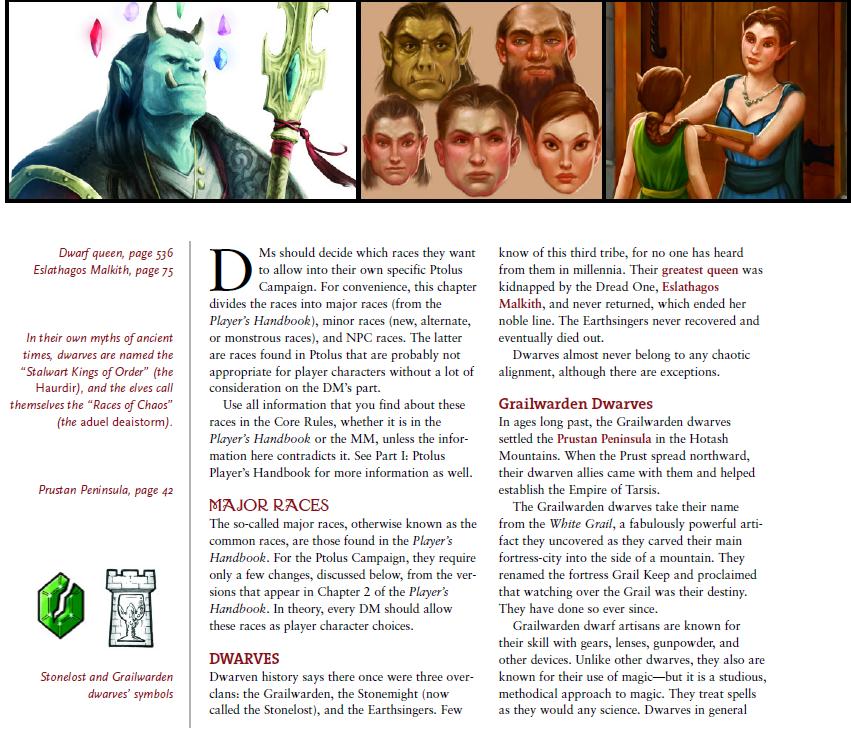
Over to the left is an overview of typical information: page references to important people/places/things, minor notes on setting material, and the occasional picture. In this one, we have the two racial symbols for the dwarves.
Major Races
Dwarves are a humanoid race comprised of three clans: the Stonelost (formerly Stonemight), Grailwarden, and Earthsingers.
The Stonelost dwarves are a displaced people forced out of their ancestral home of Dwarvenhearth, which is conveniently located and sealed up beneath the city of Ptolus. They're accomplished artisans, engineers, and merchants. They left Dwarvenhearth of their own volition, feeling that they're too disgraced and unworthy to reclaim it; for this reason they don't really talk about it much among other races. They use the standard PHB stats for dwarves.
Grailwarden dwarves settled the Prustan peninsula long ago and found an artifact known as the White Grail while tunneling into the region's mountains. They felt that it was their destiny to guard this relic, and thus the origin of their name. They are known for their knack with advanced technology such as lenses, gears, and gunpowder, and are strong allies of the Prustan humans. They're also more open-minded to magic, but they prefer the more studious and methodical kinds. Grailwarden dwarves replace the bonuses against orcs, goblins, and giants with +2 bonus on various Craft and Knowledge checks related to technology (Alchemy, machines, architecture and engineering, etc).
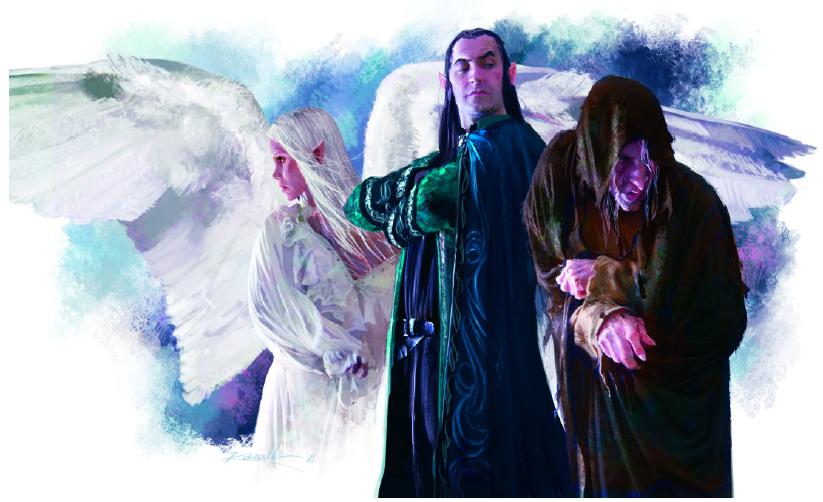
Left to right: Cherubim elf, Shoal elf, Harrow elf.
Elves revere the moon and are one of the oldest races of Praemal. In ancient times gnomes and halflings were considered kinds of elves, but not anymore. The elves proper are split into Shoal Elves, Dark Elves, Harrow Elves, Cherubim Elves, and the extinct two Elder Elven subraces: the Solarr and Lunas Elves (which cannot be chosen by PCs). An interesting note in Ptolus is that elves sleep normally like humans, and their culture places a great emphasis on dreams.
Shoal elves are the most populous elven subrace, just as much home on sea as on land. The majority live in Palastan, Ren Tehoth, and the Sea Kingdoms. They used to have great cities in the past, such as Dreta Phantas, but most of them have been magically stolen away by the dark elves and they now live among the other races. Shoal elves used to be arrogant and racist like elves of so many other settings, but over time these attitudes have faded away.
Shoal elves are like standard PHB elves, except their favored class is sorcerer, +2 on Profession (Sailor), and need a good 8 hours of sleep. Overall I really like how Cook departed from the traditional Tolkien elf with Shoals in favor of something more original.
Cherubim elves are a rare elven subrace native to the Cherubar Mountains to the west. They really don't like interacting with the other races, instead keeping to isolated villages out of reach of non-winged people. They are very timid and avoid conflict, feeling skittish around even other elves. Also, a lot of non-Cherubar mistake them for angels, which causes real angels to detest Cherubim elves in general. Racist angels? I'd never have imagined that.
Game-stat wise, Cherubim elves have +4 Dexterity but -4 Constitution, have a +2 bonus only to Spot checks and not Listen and Search, have a Fly speed of 40 feet and a Level Adjustment of +2. Overall flight is a very powerful option, but the way level adjustment works means that you're not going to be a spellcaster, and your hit points are going to be very low, limiting you to dex-based skirmisher and ranged builds.
Harrow Elves are Shoal Elves whose ancestors were long ago captured by the forces of Ghul and held them in the dungeons beneath Goth Gulgamel (a fortress of evil halfway up the Spire). Vile, torturous experiments tainted them with the touch of evil, and Ghul released them into the world as a warning to others what he'd do to people who resisted his rule. Today harrow elves lost much of the evil taint, but some of this still manifests as supernatural powers. Physically deformities and a reputation for "being evil" results in near-constant discrimination and bigotry towards harrow elves, even though there is no natural inclination anymore towards being of evil alignment. Naturally this makes a lot of them bitter and resentful towards others.
Stat-wise Harrow elves have +2 Dexterity but -2 Constitution and Charisma, +2 on Craft (alchemy), Intimidate, and Use Magic Device checks, and can cast 4 0-level spells as spell-like abilities once per day (detect magic, ghost sound, mage hand, prestidigitation) and one 1st or 2nd level spell of the player or DM's choice. Their favored class is Monk, and they have a +1 Level Adjustment. A rather underpowered race undeserving of the Level Adjustment, in my view.
Gnomes are the rarest of the major races, and are alternatively known as loresong faen. They dwell throughout the lands of Palastan, Rhoth, and the Sea Kingdoms.
Halflings frequently live among humans, but just as many wander the plains to the south in nomadic caravans. They call themselves saelas faen, or "quicklings," but they don't find it derogatory anymore when other races call them halflings.
Half-elves and half-orcs are overall uncommon and most live in Ptolus. Half-elves are always half-Shoal, as Cherubim elves would never breed with humans and harrow elves always breed true. Most half-orcs are of the Ornu-nom tribe of Palastan and Roth.
Humans are said to be the youngest of the races by dwarven and elven scholars, but they are the most prevalent race on Praemal, and their various cultures are the most prominent in the world. Not much else to be said about them.
Minor Races
Now we have the Minor Races, who aren't "minor" so much as them not being a typical choice as a PC option in most D&D games. Technically Cherubim and Harrow elves fall under this category, but I chose to put them with the other elves to be consistent.
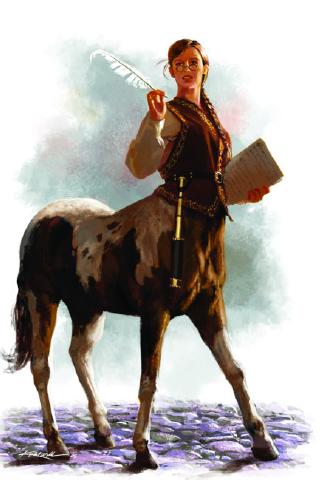
Centaurs , also known as the Aram, live in great numbers in Palastan and thus in and around Ptolus. They get along with the humans due to their open nature and help in fighting Ghul's forces in the past. They travel and live in herds and hate doing things which would require them to be stationary for long periods of time. In Ptolus most of them live in the Midtown neighborhood of Narread and often perform physical labor and messenger work. One of the founders of the Delver's Guild, Turias, was a centaur adventurer.
Game-stat wise Centaurs use the game stats from the Monster Manual and thus are effectively Level 6 before they get their first class level. This really, really hurts their option as a playable race, and the boosts to physical stats do not make up for this. Their forms are also ill-suited to vertical climbing and dungeon-delving, and given that the latter factors heavily into Ptolus, they're not a good choice for players.
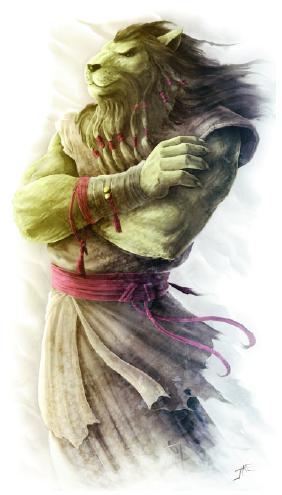
Litorians proud lion-people who live in grassland tribes isolated from other races. It is the rare, individual litorian who comes to Ptolus or other such communities. Litorians live by a personal code of honor which varies by individual, but most relate to being true to oneself and are almost never compromised. The book is contradictory, in that it says that each of them creates their own set of morals and ethics on an individual basis, yet most hold the welfare of family and community as paramount, and view being a liar and/or coward as a fate as bad as death. They also place a great value on paying off one's debts, from it being financial to returning favors done by others. Those who save the life of a litorian will find themselves a staunch ally. They really don't hold any of the other races as enemies, and get along rather well with centaurs, halflings, and the Ornu-Nom orcs (but not the Toruk-Rul or Sorn-Ulth, who hate everyone else). They also recognize the existence of deities, but do not see the point in worshiping any entity.
Game-stat wise, Litorians gain a +2 bonus to the three physical ability scores, have low-light vision and scent, are Medium size, and have a +2 bonus on Intimidate, Listen, Search, Spot, and Survival checks, and Ranger as a favored class. And a +1 Level Adjustment, which again doesn't feel worth it. Sort of close, in that they have a net +6 and scent, but I don't think that it merits a whole level.
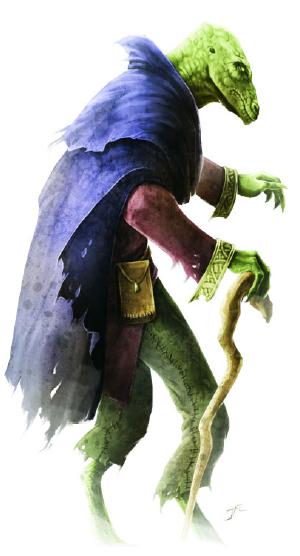
Lizardfolk, or Assarai as they call themselves, once dominated the west but whose numbers dwindled as other, more mammalian races incorrectly assumed that they were evil. Today, assarai live meager existences and want only the simple things in life. They don't live in permanent homes and can stand all but very cold climates, accept odd jobs to buy food and clothes, and simply dig through garbage left by others for things they might need. This gives them the stereotype as lazy parasites and shifty folk, but the reality is that they can work just as hard as the other races for just enough to get by and rarely steal. They face the most discrimination of the races of Ptolus (save for dark elves), and the city watch often forcefully drives them off of the streets and docks where they often sleep even though what they're doing technically isn't illegal. Due to their homeless status and physical endurance, many slavers target lizardfolk; as a result, anti-slavery sentiment is one of the few things assarai feel strongly about, and many adventurers among their kind got their start busting up slavery rings.
Game-stat-wise assarai use their Monster Manual character entry. They don't get much except for a bite and 2 claw attack, +5 natural armor (which is pretty sweet), +2 to Strength and Constitution but -2 Intelligence, the ability to hold their breath for long periods, and 2 racial hit dice and +1 level adjustment, making them 3rd level characters before their first class.
In my Ptolus game one of my PCs was a lizardfolk monk. The racial bonuses did not make up for the weakness of the class and race, and over time the player got tired of getting a hard time from Ptolusites who saw him more as a pest. He then switched over to another PC option, a human this time. It was a shame, though, as the character concept was interesting, and I should have as a DM tossed out some positives.
What I'm saying is, despite making strides to accommodate some of the monstrous races, Cook doesn't do enough mechanically to make them a viable long-term option (except maybe for the litorian). If you want to play a monster PC in 3rd Edition, use Oslecamo's variant rules instead.
NPC Races
These are prominent races of the campaign setting which are not meant for PC use without special DM permission, meant to be more suited for existing NPCs.
Aasimars are more common in Ptolus than elsewhere due to the angelic Malkuth. Aasimars are typically viewed with awe and respect, and virtually all of them are good-aligned and reinforce their reputation with selfless, heroic deeds. Most aasimar in Ptolus live among the Malkuth in or near the Pale Tower.
Dark elves are said to originate from corrupted stock of Shoal elves by the evil goddess Gorgoth-lol, a Vested of the Galchutt (we'll be talking more about them in Chapter 4). They were taken underground to build up their forces, and they continually plot to destroy all other elves and the people above ground. They are almost all evil-aligned, and it's inherent to their being due to Gorgoth-lol's manipulations. They can overcome it, theoretically, but they almost never do. They love betrayal, poison, sadism, being scantily clad, and all that other drow stuff.
There is one race they hate even more than the elves and any other creature: the zaug, a race of disease-ridden evil outsiders with a penchant for Chaositech (evil Lovecraftian technology), and drow have even allied with other underdark races against these creatures.
Minotaurs are usually dumb and primitive, but a few among their number are unusually intelligent and magically-inclined, and seek to live away from their own kind. These "civilized" minotaurs often flock to cosmopolitan centers such as Ptolus, but even then they're barely tolerated and distrusted. Minotaurs are carnivores.
Interestingly, a player in Monte Cook's game wanted to play as a monster, a Minotaur wizard, to be exact. Cook rolled with it and made an alternate racial traits to make the idea possible. Canabulum, said minotaur, grew to become a major PC in the campaign, and the exploits of his adventuring party are available in one of the campaign journals.
Unfortunately, Cook has not presented his alternate options in this book for those who wish to follow in Canabulum's footsteps.
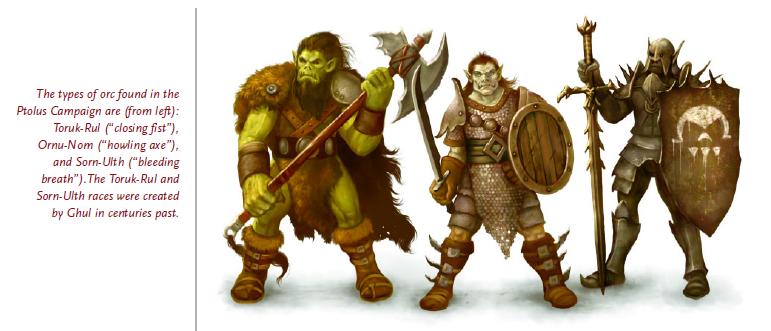
Orc myth contends that their race was birthed by a demon god, but some ancient texts claim that they were made by a cabal of evil wizards. The orcs who lived in the area around Ptolus were magically altered and bred by Ghul. Today two of these altered tribes remain: the Toruk-Rul (Closing Fist), large, bestial orcs who ferociously embody everything you think of when you hear the word "orc." The Sorn-Ulth (Bleeding Breath) are shorter than their other kin, but have a knack for stealth and evil magic. Both of these tribes live along the coast of the Whitewind Sea.
The Ornu-Nom (Howling Axe) never suffered Ghul's manipulations, and dwell in the wilderness throughout Palastan and Rhoath. Despite being no more evil than humans as a whole, the negative reputation spawned by Ghul caused many humans to war with them, and they have very poor relations with the two nations and Ptolus as a result. A prominent tribe of Ornu-Nom orcs live in the area just outside the city itself.
Tieflings in Ptolus are primarily the result of the Fallen, a faction of demons living in the Dark Reliquary of the Necropolis. Many of their number work alongside their fiendish relatives, and among the fiend-worshiping Forsaken. Other tieflings abandoned these ties to make an independent living, usually as criminals, assassins, and evil clerics. Almost all of them are evil, and most are chaotic. The nobles of House Vladaam, one of the aristocratic families of Ptolus, is primarily composed of tieflings.
Thoughts so far: All but the litorians are derivations of existing races of Dungeons & Dragons, but Cook applies a creative spin on enough of them to make them stand out amid their counterparts of other campaign settings. I like his rework of the "base" elf, and while I don't particularly enjoy the implementation I do like his idea to accommodate some of the monstrous races as PCs and into Ptolusite society proper. I also like how he veered away from the typical "evil orc," making the stock trope the result of two prominent clans giving the rest a bad name. His information on gnomes, halflings, and humans is really bare, and elves in general get a disproportionate amount of screen time, but that's really my only other complaint.
Next time, Chapter 4! The cosmology and religions of Praemal!
Cosmology and Religion
Original SA post
Sorry guys, I forgot to mention that the Earthsinger clan of dwarves are no longer around.

Chapter 4: Cosmology and Religion
So basically there was this elder deity named Praemus. He's responsible for the creation of the world of Praemal today, from which comes his name. The Galchutt, the primordial Lords of Chaos and entities of greatest evil, plotted to spread their taint to this plane as well. What they did not realize is that this world was created primarily to trap them, keeping the rest of the Multiverse safe from them. Upon the Vallis moon the deity placed the soul of the world, anchored in place by seven golden chains guarded by seven golden solar angels who built a citadel on its surface. The Galchutt were trapped, but would struggle against their bondage, so Praemus seeded the world with the first living beings to act as wardens, blessed with sapience and free will to better fight against the prisoners' manipulations.
The Galchutt:
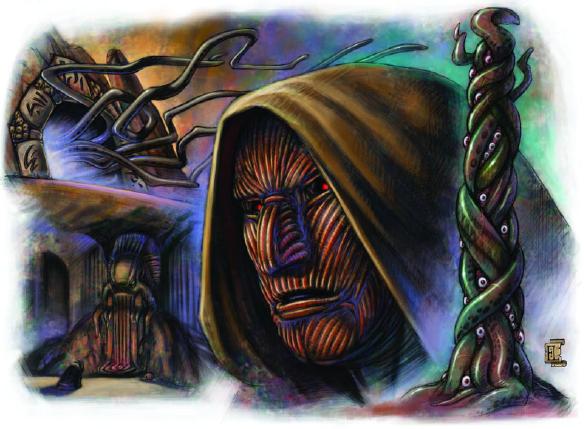
The Elder Gods, who were Praemus' children and no longer worshiped or known in modern days, rebelled against him once they realized his plan. The viewed it as unjust to trap anyone with the Galchutt, the most horrible creatures in all of existence. They fought against their father for eons in Heaven, during this time civilizations rose and fell on the plane of Praemus, and mortals met the Galchutt for the first time. Praemus and his children made peace so that they could help the mortals fight against the Galchutt, who sought to destroy the Seven Chains' guardians with a magical virus. They had to send the Vallis Moon, and the soul it guarded, hurtling away from Praemal and thus out of reach of the Galchutt. Thus the moon's disappearance.
With the world safe, Praemus and the Elder Gods made an arrangement so that people can only leave the plane with Praemus' permission, and only then if he was on that same plane. They all decided to leave Praemus together, effectively sealing the place off from all but the bordering Ethereal Plane. However, the Elder Gods still felt it wrong to keep the plane as a prison, and enacted a plan that mortals could take advantage of by ridding the Galchutt from the plane once and for all. This plan would require the return of the Vallis Moon and tricking the Galchutt into leaving the plane by mortal action along with several magical artifacts, into a new prison plane built by them. Said plan was used by Monte Cook as part of a campaign goal, and he provides advice on how to do so later on the book.
Praemus permitted this, and in secret created a hidden means of the plane's wardens to become gods of their own so that they can better fight the Galchutt.
It should be noted that this ancient history is not common knowledge by most people. Only the most rare and ancient of texts speak of Praemus and the Elder Gods nowadays, and the Church of Lothian does not teach or claim any answers as to the world's creation (they maintain that looking too deep into such things is evil).
The Seven Chains:
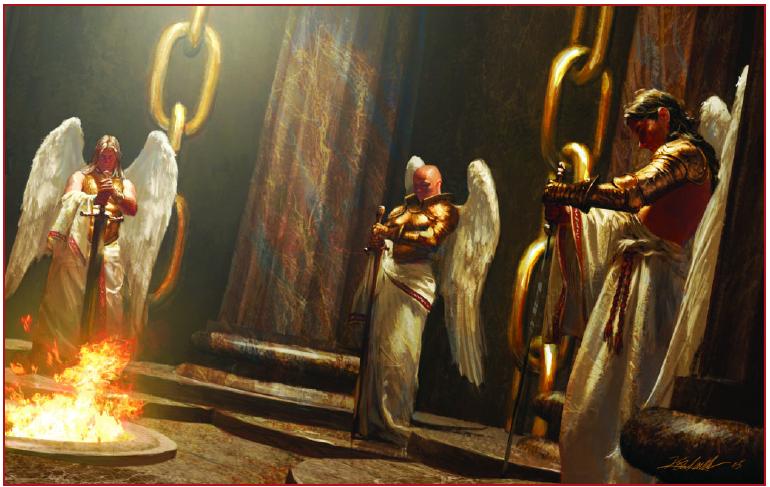
As a prison plane, Praemal is subject to several rules. For one, the only other plane people (including gods) can travel to is the Ethereal Plane, which receives an upgrade in this book to make it a cooler place to visit. Plane Shift, Astral Projection, and the like don't function. Banishment does not force outsiders to their home plane, it only stuns them. Summon Monster spells work in that they summon only a facsimile of the entity instead of the real thing. Summoning spells with the Calling descriptor create a one-way trip to Praemal, and outsiders rarely heed the call. Ones who are called into Praemal but find they can never leave usually kill said summoner in anger, so these spells aren't used as much as in other settings. Powerful spellcasters are capable of drawing energy and making gates connecting to other planes, but they're all one-way as well. The only way to actually break out of this plane is to break the Seven Chains on the Vallis Moon and destroy the soul of the world. An era known as the Night of Dissolution prophesies of when the Vallis Moon returns, and the Galchutt plot for this day to come.
As for other outsiders, the Galchutt used to rule over all the lower planes, but when they left the demons and devils came to rule in the resulting power struggle, but the two Elder Gods spawned a child named Raguel to rule over them. Being not evil himself, he didn't relish the task and delegated authority to folks like Orcus, Demogorgon, and the like. He eventually left for Praemal to find his parents, but now he's trapped. He now holds court in the Necropolis in Ptolus over a bunch of fiends known as the Fallen. In fact, the vast majority of the plane's demons and devils are a part of this group, and as such are very rare elsewhere in the world.
The other major group of outsiders on Praemal include the Malkuth, good-aligned outsiders who willingly entered into the prison plane to perform some vital task. Most of them gather in Ptolus as well.
The Ethereal Plane is much like the standard one, except it's populated with masses of ether which can be formed into solid stuff and matter. These Ethereal Islands as they're called, are finite and have their own rules and functions, and basically serve the same role as demi-planes. Powerful folk often use them to create half-worlds and lairs for themselves.
Religion in Ptolus
Basically, discounting the Elder Gods and Galchutt (who can grant divine spells and domains), the gods of Praemal are all ascended mortals who completed a spiritual journey lain down by Praemus and ascended to divinity after talking with him. Much like in other settings, there are all kinds of deities for all kinds of things, but in the Empire the Church of Lothian is dominant. Additionally, deities who are no longer worshiped eventually die as the last of their power wanes. So like in some settings the number of faithful translates to a deity's power and well-being.
In pre-Imperial times Lothian was a simple wanderer in ancient Prust who claimed that the people's dominant religion (the church of Castain) was all corrupt, and that their god was a devil posing as one. He also manifested divine powers to heal the sick and claimed to be on the path to godhood himself. The kingdom and church of Prust did not like this, so they crucified him on an ankh, the symbol of Castain, to make an example of him. A great earthquake tore apart the land and floods killed off most of the clergy and nobility. And Lothian came back as a living martyr. Lothian, now recognized as a god, had his clerics take over the engine of the church, including most of its symbolism, and became the dominant Prustan God.
Sound familiar? It should, because Monte Cook just based Lothian off of Jesus Christ, and the Church of Lothian's pretty much the Roman Catholic Church. I'm not kidding, look at this:
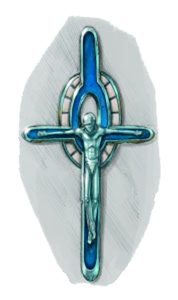
Lothian died for your sins!
So the Church of Lothian grew along with the Empire, quickly becoming the dominant religion, and a separate yet powerful instrument of Imperial life and politics. Most worshipers maintain that Lothian became the greatest of the gods in Heaven, although the fundamentalists maintain that all other gods are devils in disguise. The latter was used to outlaw worship of other religions in the Empire, and eventually grew to encompass arcane magic. It's only within the last 200 years that these attitudes softened. and other faiths started worshiping their gods openly (although this is more due to the church having less power now than genuine tolerance).
The religion itself is called Lothianism, and the Church of Lothian takes the trappings of real-world Catholicism. Its houses of worship are cathedrals, the ankh with Lothian hanging from it is their holy symbol, clerics are called priests, ministers, bishops, and other things depending upon rank, and the Holy Emperor is pretty much the Pope. Each community looks to a bishop, who operates out of a cathedral and coordinates with the local governor or Commissar, and each cathedral is linked to a dozen or more smaller satellite churches managed by high priests in smaller villages or city districts.
Lothian's a Lawful Good god who grants Good, Law, Protection, and Sun domains, and his favored weapon's the longsword. About half of church officials are Lawful Neutral, though, and disproportionately fill up the higher offices.
The current Holy Emperor, Rehoboth Ylestos:
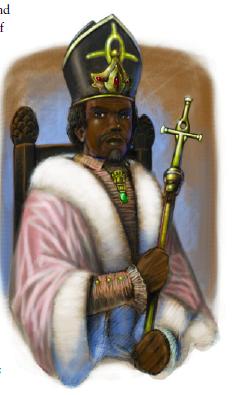
Ptolus is different, of course. It's long been a bastion for nonbelievers and arcane spellcasters, and today the city's faithful is an eclectic mix of all sorts of deities of all sorts of concepts, sometimes worshiped together in a pantheon or on their own depending upon individual and community fancy. Lothianism comprises 60% of Ptolus' faithful, where in other lands in the Empire it would be be around 99%.
The church has 3 major specialized orders beyond the rank and faithful. The Order of Dayra is an all-female order who runs hospitals, orphanages, soup kitchens, and generally help those who don't have the means to help themselves. The Order of the Dawn is the martial arm of the church, full of holy knights who defend cathedrals, sacred relics, and comprise the Holy Emperor's bodyguards. The Conciliators are basically the fantasy Inquisition. In old times they enforced the Edict of Deviltry and tortured and killed arcane spellcasters, heathens, and some genuine evil cultists. In modern days they're not as bloodthirsty, but they are still an experienced force dealing with genuine black magic. In fact, the Conciliators not only know of the Galchutt and the full history of the Spire, but they secretly work in Ptolus to root out Cults of Chaos and to destroy any Chaositech (weird Galchutt science) they can find. They also oppose the efforts of delvers who venture beneath the city, who they fear will inadvertently unleash more evils.
Other Gods and Goddesses
Beyond Lothian is a bunch of deities with short descriptions. Monte Cook designed Ptolus with a rather incomplete pantheon, allowing for DMs to add what deities they want and to actually work with players in developing just the right one for their Cleric/Druid/Paladin PC. Or even import a deity from a campaign setting that you like, Ptolus' Street of a Million Gods has the room!
Regardless, we get a list of them. A lot of them are minor with one-word sentences along with a title, alignment, and domains, so I'll detail only the more interesting/prominent ones:
Castain, that god whose church Lothian wiped, is in fact not a devil at all. He's a Lawful Good god of life. So essentially this means that Lothian was lying and committed a divine coup. I think that Monte's trying to tell us something, guys!
Celestan, Lord of the Silver Moon, Neutral Good main deity of elves. Moonsilver and other materials elves are known for are said to be gifts to his people.
The Demon Gods (Demogorgon, Orcus, etc). A catch-all category for Abyssal lords.
Father Claw, the Serpentine Lord. Chaotic Evil dragon god who's one of the oldest non-Elder deities.
Gaen, Goddess of Light. A large and powerful Lawful Good religion in Ptolus, Gaen's followers struggle against evil at every turn. Her temple in the city is one of the largest and most impressive.
Gorgoth-Lol, Chaotic Evil goddess of the Dark Elves, originally one of the Vested of the Galchutt.
Mocharum, God of Dwarves. Lawful Good, most popular among Grailwarden dwarves.
Navastrom, God of Strength and Harmony. Neutral Good god who's popular in Ptolus, especially among adventurers and warriors.
Phoebul, God of Dreams. Chaotic Neutral God who is the patron of Dreta Phantas, the Dreaming City which was stolen away by Dark Elves.
Teun, Mother of All Machines. A Lawful Neutral and old Prustan goddess, she oversees technology and is popular among grailwarden dwarves.
Unnom, Lord of Caverns. A Neutral dwarven god who is worshiped by all manner of subterranean dwellers.
Ynchabulos, God of Numbers. Lawful Neutral god of knowledge, logic, and order. His faith is small but supported by influential people in the city.
There's also 24 gods for each hour of day, but they're not detailed here, sadly. They do have a write-up in
Secrets of the Delver's Guild,
a supplement for Ptolus sold separately.
Cults of Chaos
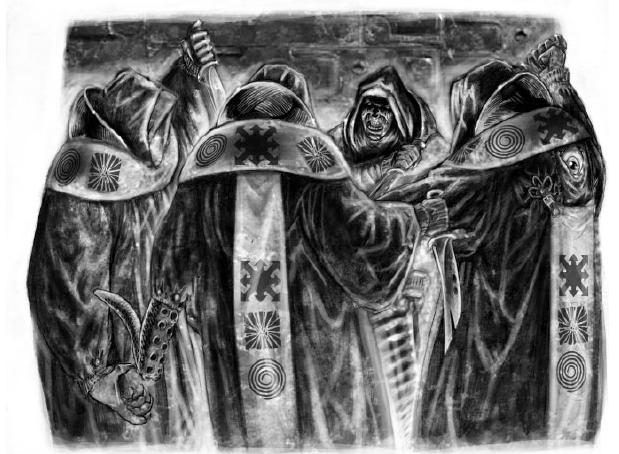
The Galchutt have their faithful as well, even if most of them don't truly comprehend the nature of their deity. The groups are fractured and independent, putting their own religious spin on things. Due to the Galchutt's influence, even the most isolated end up using the same symbols and "doctrines" if they can be called that. There are a myriad assortment of cults; the following are some of the most common and prominent.
The
Brothers of Venom
enact their masters' wills through slow and subtle works. Killing the right community leader here, poison in the town's well here, they have small cells of only a half-dozen members whose plots take years to come to full fruition.
The
Crimson Coil
are savage and violent, who wear blood-red robes and attack people in great flash mobs with torches, axes, and other implements of destruction. They always use overwhelming force beyond the task at hand so that they cannot be conventionally stopped: a hundred to burn down a building, a dozen to kill a guy on the street, they appear suddenly in a community to work their evil, then retreat into their well-fortified and trapped fortresses in the wilderness. Many have organized armies and militias to kill off the Crimson Coil cells, but always at a great loss of life. And word of their destruction always brings more worshipers into the area over time, like a growing disease.
Deathmantle
is a cult which reveres death itself. They have close ties to the Forsaken in Ptolus, and many of their senior members are vampires, liches, and other forms of undead. Their ultimate goals involve great acts of murder, from war to genocide. The more people a cultist can kill with an action, the more sacred the act.
The
Ebon Hand
worships the act of physical deformity, and enjoy using vile magic to warp body, mind, and soul. Their main form of recruitment is to kidnap children and adolescents to brainwash and deform; most are killed during these trials, but the rest inevitably join the ranks. They are very resilient in that their numbers are small, secretive, and are more than willing to abandon their temples and flee at a moment's notice.
The
Order of the Blooded Knife
has its origins in prehistoric times, when a bloodthirsty tribe made human sacrifices to a moon goddess whose name is no longer remembered. In the present day they maintain much of the ritual, but they often pose as members of more legitimate religions in order to infiltrate society. They also gather a lot of resources through the vice trades, like gambling, drugs, and prostitution.
The
Plagueborn
seek to turn the spread of disease and pestilence into an art form. They take the rat as their symbol and make their temples deep in trash heaps, sewers, and other places of filth. In Ptolus they have close ties to the ratmen living in the sewers. They do not use standard Chaos Cult symbols, instead leaving hunks of rotting meat hanging from chains at crime scenes.
The
Tolling Bell
cult, as a whole, is the only cult with a full awareness of the Galchutt and their plans. They take their name from ancient texts which describe the coming of the end of the world like the tolling of a bell. As such, they seek the end of the world to free their masters. They draw most of their numbers via the other Chaos Cults, preferring those with established power, skill, and forbidden knowledge to join their ranks. They research power spells and artifacts believed to help bring about cataclysms, believing that multiple events will in turn trigger even bigger extinction-level events.
Thoughts so far:
I feel that making Praemal a prison-plane is yet one more reason to focus all the action in the City by the Spire. But Cook does a good job of making it thematic to the world. I do like the idea of having gods as ascended mortals and the open nature for the inclusion of homebrewed deities in the campaign. The Etheral Islands are designed so that you can have all sorts of mini-planes in spite of having just the Material and Ethereal, so Monte did a good job fixing that potential pitfall.
Regarding Lothian I have mixed feelings. Having a Christian expy is not anything new to fantasy games, but I don't know what to think about the blatant "I AM JESUS!" symbolism everywhere.
Next time, Chapter 5: History!
History
Original SA post
Alright guys, looks like this is going to be my final post on the thread then!

Chapter 5: History
The world of Praemal is nearly 11,000 years old. Mountains, oceans, and other natural features are the results of the Elder Gods, Praemus, and the Galchutt's battles against each other in the forgotten times. Written history goes back only about 8,000 years. Beyond that things are unknown. The most common calendar is the one used by the Empire, with the common date of measure being before and after it was formed: BE stands Before Empire, while IA stands for Imperial Age. The current year is 721 IA.
So the events of the previous chapter, with Praemus and the Galchutt and the Vallis Moon, occurred from 10,000 BE to 9,000 BE.
Dawn of History, and the Dread One
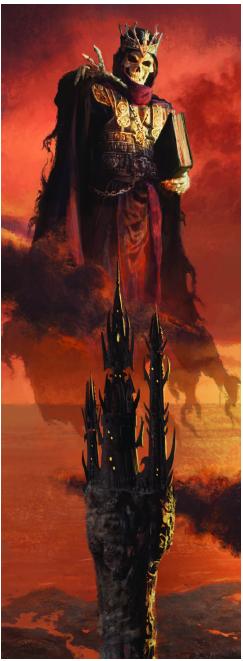
In 8,000 BE, the scales are tipping against the Galchutt and their minions. Goblins, the undead, and other such creatures were forced underground, new ascended mortals who became deities filled the hole left by the Elder Gods, and civilizations began to form. This all changed when a well-intentioned Cleric named Danar Rotansin set upon a plan to gather up all the evil artifacts, chaositech, containers of imprisoned fiends, and other bad majo to be gathered up and sealed away. Danar theorized that these "banes," as he called them, would only spread their evil if he attempted to destroy them, so instead he buried beneath his tower, Mosul Pearl, in a series of vast catacombs warded with powerful magic. Unfortunately, gathering so much evil in one concentrated place exacted a terrible toll on the land, which thrust the tower of Mosul Pearl away from itself in that 3,000 foot Spire we all know and love. The Galchutt also manipulated events so that Danar would come across the Book of Inverted Darkness, a tome penned by gods and demons which corrupts anyone who so much as reads it. Danar lingered over it a little too long, and he could not bring himself to seal it away in the catacombs now known as the Banewarrens. And thus began his descent into evil.
Danar retreated from his friends and family, forgetting his duties and spending all his time in that tower atop the spire, now renamed Jabel Shammar. His old life forgotten, he now called himself The Dread One, Eslathagos Malkith. A few years later he used the resources of the Banewarrens to create and summon a dread horde which he used to conquer the land. Only the efforts of a band of legendary heroes could stop him, who took the war all the way to Jabel Shammar's throne room. Malkith perished, but so did the heroes. His forces repelled by an alliance of the world's races and kingdoms. To this day, the tower and the Banewarrens remain places of great evil.
We also have a short entry on the Age of the Elder Titans, but there is not much to tell. Basically the race of titans came to the shores of Ptolus in massive ships of wood and stone. They settled there and traded with the Elder Elves, but after sensing great evil in the land most of them departed. The ones who stayed behind eventually turned evil. There are hardly any titans left today in Praemal.
Ghul the Half-God
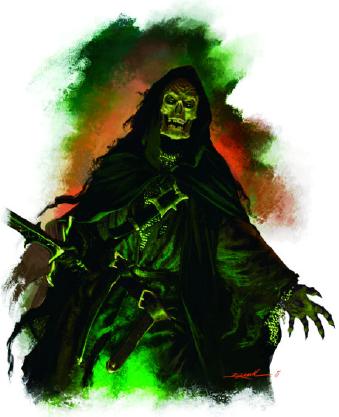
A half-demon sorcerer from the land of Kem ventured the world in search of ways to enhance his already-great magical power. When he came to the land around the Spire, he knew his search was over. He told people that he was the Dread One's Son and a half-deity, and claimed the Spire as his birthright. These were all lies, but that did not stop him from living up to the dread legacy. He discovered the Entropy Sphere, a virtually limitless power source located inside the Spire, and built his fortress, Goth Gulgamel, at an access point halfway up the unnatural stone formation. He then created hordes of monstrous servants, taught them the Abyssal language, and ordered them to carve out vast caverns as living spaces which now comprise a good portion of the dungeons below Ptolus today. He used the Sphere's power to bring two centuries of darkness into the world and sent his Squirming Horde out into the world to annihilate those who resisted his rule.
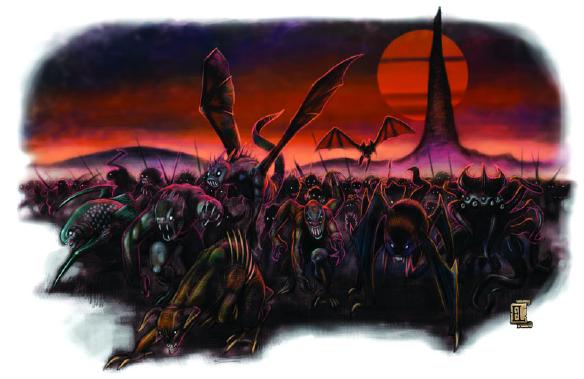
It was by the efforts of an elven wizard-priest and 7 heroes that Ghul's armies were pushed back. The Brightfather's Day Pact was an alliance of humans, dwarves, elves, centaurs, and pretty much anyone and everyone Ghul fought. The two-hundred year spell of darkness was lifted, Ghul's forces were scattered, and the Half-God was chased out of his fort and slain in the Seven Jewels of Parnaith, the mini-planes which Praemus set up for would-be Gods to ascend. To ensure that no evil entity takes advantage of what has been left, the dwarves built the mighty fortress of Dalengard, ensuring that Goth Gulgamel lay vacant for centuries.
The Rise of the Empire
The last 700 years are the most well-documented, and thus the one most schoolchildren know. The Prust and Grailwarden dwarves had a strong alliance even before the Empire's formation. Their influence spreads northward into Tarsis, reputedly the oldest and largest city in the world. The Prust and dwarves believe that the city had always been there (the Eternal City), and that it was destiny that they should come upon it and plant the seeds for an eternal Empire. With the Brightfathers' Day Pact, they knew that day had come. Delian Von Tessel, the human signer of the Pact united the squabbling nobles under his domain and became the first Emperor of Tarsis.
Due to the widespread devastation of war with Ghul's Horde, and the wealth, organization, and technology brought by Tarsis, most lands welcomed the Empire's assistance to help rebuild society. By 100 IA, the Empire claimed all the lands in the known world. And for a time, all was good.
But all good things must come to an end. There is much disagreement on when and why, but most everyone acknowledges that Tarsis' glory days are fading. By 560 IA, the Emperor passed the Edict of Deviltry with heavy Lothianite influence, declaring all arcane magic illegal. The Church gained wide-sweeping powers to incarcerate, punish, and execute people believed of violating Church doctrine. The clergy abused its power and the two Inquisitions it spawned are looked back on with shame and regret. So many people were killed that the era became known as the Days of Blood. By 641 IA the Edict of Deviltry was overturned once public opinion turned against it and more Imperial regions stopped enforcing it. During this time many arcane spellcasters fled to Ptolus, paving the way for the creation of the Inverted Pyramid, the strongest bastion of magicians in the world. People's faith in the goodness of the Empire and Church had been shaken, vast stores of knowledge were lost, including the creation and maintenance of advanced technology.
By 706 IA, the current Empress died with no heirs. A cousin of hers in Dohrinthas claimed legitimacy and named herself Addares XXXIV. Many opposed her rule, including Imperial advisor Segaci Fellisti, who felt that only his political acumen could save the Empire. And then the Holy Emperor Rehoboth Ylestos claimed his right to the throne, figuring that he's the only person with the name "Emperor" in his official title. If successful, he'd rule the Empire with both secular and religious authority, like the first Emperor did in days of old. Citizens of the Empire itself were split, along with armies and taxes to the 3 separate figureheads. This devastated the Empire, which King Oulgas and his barbarian horde took advantage of in 710 IA.
Barbarian Invader:
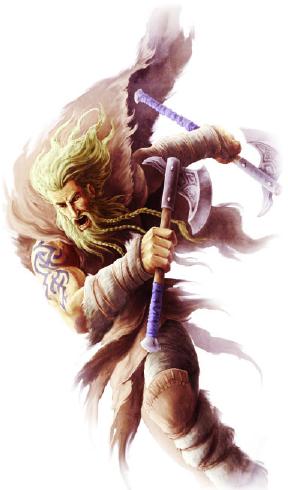
We get a write-up on the personalities of the 3 would-be Emperors, along with potential futures should any of them come to power.
Addares XXXIV is more interested in the novelties of office than actually ruling, and never set foot in Tarsis. If she becomes Emperor she'll declare Dohrinthas the new capital, to much anger and resentment. Various lands would declare their independence, and she might well hasten the Empire's collapse within the next 10 years.
Segaci Fellisti feels that the Imperial bloodline has come to an end, and that he must rule in their stead. He has a lot of skill in political and bureaucratic affairs, and dedicated to restoring the technological glory days. However, his single-minded determination to this progress caused him to make some unfortunate alliances, including with Ptolus crime lord Kevris Killraven and the Shuul. If he takes the throne, Ptolus' technological knowledge will be put to use strengthening the Empire's infrastructure, and vast sections of the army will benefit from firearms. Eventually he'll declare war on the Eastern barbarians and wipe them out once and for all.
Rehoboth Ylestos fled Tarsis when it fell to barbarians, and has extended his "visit" to Ptolus for 11 years. This has earned him a poor reputation among Imperial politicians, and his eventual plans to declare Ptolus the seat of the Empire will earn widespread outrage. If he gains the throne, the separation between church and state will vanish under his rule, but he'll forbid the rise of new Inquisitions. He is not a reactionary zealot, and he does not want to lose the support of the people by bringing those dark days back. In his obsession to become a beloved Emperor and restore the Church's good name, he'll make great political concessions which will weaken the Empire.
Thoughts so far:
As you can tell, much of the interesting bits of history center around Ptolus. This is intentional, as the place's magic draws all manner of people there. I sort of feel that Malkith and Ghul's reigns are a bit too similar, even if the latter is living off the legacy of the former: evil overlord, forms a fortress and army of evil, the other races band together to turn the tide and the bad guy's slain by legendary heroes. Some more variety in the story-telling would have been nice.
Barring the whole barbarian genocide thing, Fellisti is overall the best choice in terms of Imperial stability, with Addares clearly being the weakest choice. The options feel a little too cut and dry, as PCs who gain enough knowledge of Imperial politics will likely choose Fellisti or Rehoboth depending upon their background. Addares doesn't really have much going for her at all.
Next time, Chapter 6: Organizations of Ptolus!
Organizations
Original SA post
Chapter 6: Organizations
This is a very big, and very important chapter, for it details the prominent power players of the City by the Spire, and more importantly how they impact the people of Ptolus and interact with each other. In a city of 75,000 souls built above ancient chambers of evil, you have all sorts of interesting characters trying to enforce their will on the world. They run the gamut from noble houses, vile cults, organized crime syndicates, knightly orders, and mystical orders.
Noble Houses
Traditionally there are ten families in Ptolus who are granted special rights and privileges by the city's Commissar. Although traditionally the Empire of Tarsis subsumed local rulers with their own Commissars, Ptolus is far enough removed that the nobility of Palastan still holds clout in the region. In addition to the Commissar's influence, an ancient king of Palastan manifests as a ghost in secret meetings between all the houses, maintaining stability between them by threatening dire curses on those who break the Ancient Rites of Custom, which forbid nobles from murdering one another.
It should be noted that in Ptolus, "nobility" does not automatically mean "levels in Aristocrat." More than a few of them have levels in PC classes, and the heads of two houses, Dallimothan, Khatru, and Sadar, have a full 20 levels in PC classes or Challenge Rating 20 (including full stat blocks)! Naturally these are only the most powerful noble houses, and quite a few of the lesser nobles are low-level.
House Abanar is the wealthiest noble family, comprised of merchants who have a poor reputation among the houses. One can literally buy one's way into the family with 10,000 gold pieces for an official title, and hire out mercenaries and bounty hunters against those who threaten their holdings.
House Dallimothan has a storied relationship with dragonkind, specifically the metallics. It is not uncommon to see such creatures basking in the sun in courtyard, and even roaming around the estate's open outdoor areas. Many theorize that the nobles have draconic blood, a rumor they angrily deny. Truth be told, more than a few of them are indeed ancient dragons who've taken human form. Lord Kirstol Dallimothan, the patriarch, is one such example. They forged the Sword of the Dragonkings millennia ago to help mortal heroes slay chromatic dragons, and helped destroy a few of the Orbs of Dragonkind (which they view as vile tools of enslavement).
House Erthuo is a family of scholars and gentlefolk who extensively married among elvenkind. Today most of their members are half-elves, and possess some of the finest collections of rare books and antiquities in the Empire. The head of the House, Peliope Erthuo, is currently engaged in an affair with Renn Sadar, the head of House Sadar and a married man. They share nothing in common, and places great danger upon the Erthuo family because it would force them into an alliance with Sadar and destroy their neutrality among the nobility.
House Kath are the dilettantes and celebrities of the nobility. They concern themselves majorly with the arts in all their forms, and administer the most prestigious theaters and musicians in the city. They scout out for talented children and train them to be the next generation of writers, musicians, and artists. They have an alliance with the Knights of the Chord forged in ancient times, and the family can call upon them in times of need.
House Khatru is renowned for its military history and great warriors. They maintain their own private army of a hundred well-trained soldiers, who they lend out to help Ptolus in times of crisis. The House is notorious for its disdain of spellcasters in general and those who pursue stealthy and larcenous endeavors; they regretted the Church of Lothian's overturning of the Edict of Deviltry, and they still buy into the whole "arcanists and most clerics are devil-worshipers" lies. Lord Dorant Khatru is the head of the house, a man of eighty who looks forty because an elf girlfriend cast a spell on him to gain the lifespan of her people. He doesn't realize this, thinking that good breeding and physical training make him look so youthful. He's also the head of the Order of Iron Might and one of the Commissar's 12 Commanders (advisors and lieutenants in times of emergency).
House Nagel has fallen on hard times recently, its head imprisoned for murder. Truth be told, House Sadar bribed several city officials to toss him into the darkest corners of the city's Prison without a trial. In its glory days the house had a reputation for supporting charity and good works, and helped pass many laws to prevent abuse and exploitation of the common folk. Lady Fransin Nagel is dedicating most of her time now trying to find out exactly what happened with her husband, which gives PCs the perfect opportunity to get involved. Needless to say they are enemies of House Sadar.
House Rau are scoundrels and pirates who pose as merchant vessels and mercenary craft in the Whitewind Sea. Still, lots of people know what they're up to, coining the phrase "a deal with the Rau" to mean a swindle or cheat. They have a good relationship with the city's criminal factions, the Balacazars in particular, trading political favors in exchange for financial agreements and contracts. House Khatru hates them, and were it not for the Rites of Accord he'd have gone to war with them long ago.
House Sadar is sometimes called the House of Shadows for its members' penchance with magic of darkness. Almost eliminated in the Days of blood, the house's leader at the time came into possession of the shadowstaff which helped turn the tide around. They also received help from the Inverted Pyramid, a debt no member of the House forgets. The current lord, Renn Sadar, wields the shadowstaff today and is one of the most powerful arcane spellcasters in the city (20 levels of Sorcerer). He is a conniving evil figure with many plots and schemes in the city. He is expanding a lot of research and resources into seeking the Box of Shadows, an ancient artifact that Eslathagos Malkith planned on sealing away in the Banewarrens in his "good" years before he succumbed to evil.
All members of the House have expanded proficiency with shadow magic, gaining +2 Caster Level on such spells and a +30% "more real" bonus for the shadow conjuration, shadow evocation, and weird spells.
Lord Renn Sadar:
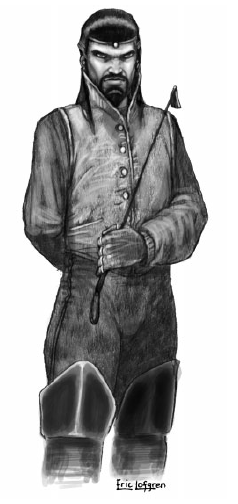
House Shever is known for its skill with machines, and in old times they wielded great political influence. Now that knowledge of advanced technology is eroding away over time, the house is finding itself in dire straits as its finances continue slipping away, and only one of the two titled sons shows aptitude in the technical pursuits. Thollos Shever, the house leader, fears that this is related to the Empire's decline and a gradual change in the fundamental nature of the world. They are allied with the Shuul technologists, and most other noble houses ignore them.
House Vladaam is the quintessential evil noble house. Thousands of years ago its founder Vladaam was one of the Vested of the Galchutt, a select few mortals and ascended deities "gifted" with some of their power. Today they are a family of tieflings who have their fingers in all manner of illicit activity, from theft, extortion, assassinations, drug and slave trades, creation of evil magic items, and supporting fiendish factions like the Chaos Cults from afar. They hope one day to find a way to Jabel Shammar, see the Galchutt rise again, and have been a thorn in the side of the world since day one. The house leader, Iristul Vladaam, is currently away from Ptolus seeking out the six hungerswords, vile weapons brimming with necromantic magic.
Navanna Vladaam runs thing in Iristul's place. She has a network of spies and agents all over the city, who are all werewolves. Aliastar Vladaam doesn't have much ambition, studying wizardry and avoiding risky pursuits. Gattara Vladaam is the eldest sibling, is insane and worships the Galchutt. Godfred Vladaam is the youngest and rather dim-witted. He is a skilled fighter, and wields one of the only hungerswords discovered yet. All of them have stats, with levels ranging from 11-15, because they of all the nobles are the likeliest to oppose the PCs at some point.
Vladaam is despised by all the other noble houses except for House Sadar, who they're allied with.
The Vladaam Family:
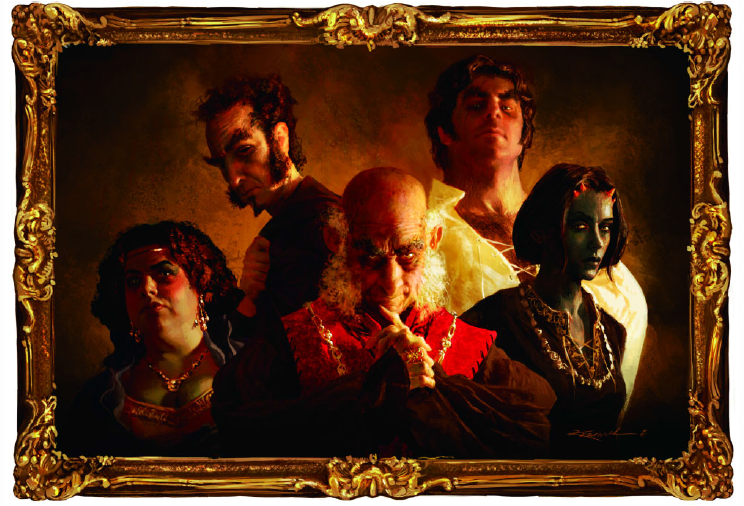
The Balacazar Crime Family
The Balacazars are the most powerful criminal faction in Ptolus. For two centuries they've sat as the top dogs, far from the Empire's reach and twisting its way into enterprises both legitimate and illegal. Menon Balacazar is the undisputed leader, a shriveled old man with an interest in black magic. Under his rule the family began dealing more and more in foul spells, ranging from evil magic items, talismans which can summon enslaved demons bound to cells in his mansion, mind-controlled slaves, and other things of a foul nature. They operate subtly, peforming crimes with deniable agents and behind fronts, knowing that the Commissar will tolerate their presence. Driving them out of Ptolus would be equivalent to bringing war in the city, and the family's not stupid enough to do anything as drastic as slaughter nobles and city watchmen in droves. Their only real opposition in the city comes from Kevris Killraven, a hag monster who arrived in Ptolus a mere year ago. Despite this, Menon still commands great influence, as the various shady factions of Ptolus, from the Forsaken to the Chaos Cults, come to him for commodities which can't be bought or traded for in legitimate markets.

Brides of Magic
A small organization composed entirely of women sorcerers, the Brides have given up their normal lives, of money and attachments to family, to pursue magic itself. They meet in secret once a month on the full moon, to discuss all matters supernatural and recent events of great import related to this. They view magic as inherently natural, a part of the world, and believe that at some point in the future will come a cataclysm which will destroy all magic and thus life in the world. They view attempts to use magic to promote ideologies as flawed, and tend to avoid aligned spells and items.

Brotherhood of Redemption
A controversial order which believes in the sanctity of all life, even those of the "evil" races and those corrupted by it. They seek to redeem evil, rather than slay and destroy it. Eighty years ago they worked with various spellcasters to come up with a ritual to turn such creatures good, using alchemical mixtures, bathing in magical light, and long-term exposure to supernatural music. Traditionally they hunted down and imprisoned evil people (especially monsters), but with the influx of delvers over the past years they found it most efficient to simply put a bounty on living evil creatures. They converted an underground dungeon complex to the Fortress of Redemption, where the creatures undergo the process. It is not open to the public, and they have a monastery in the Guildsman District as a visitor's center. Several monsters under their care have gone on to become full-fledged and trusted members of Ptolusite society, including an ogre mage cleric of Navashtrom in the Temple District.
The Brotherhood's role in the campaign is to give PCs an incentive to take prisoners of evil monsters who surrender instead of just slaughtering them and the whole "should we kill this creature just because it's evil?" Or it can be used to bring up ethical issues of free will, and if it's truly right to screw around with people's minds. Regardless, all its member register as "good" alignment.
Circle of Green
A long-extinct druidic organization which held great power in Palastan, who rarely interacted with the common people but whose word even the King had to obey. They were fair to those who did not transgress against them, but they were merciless to those who opposed them, which generated a lot of ill will. Ghul found it easy to sow discontent against the Circle, and they had no allies when his forces slaughtered the lot of them.
Dark Leaf
An all-elf syndicate of killers for hire and ruffians who help protect Ptolus' elven population from the depredations of other criminals. Truth be told, they do this by being very good fighters and valued by Killraven and the Balacazars for jobs. While they don't have a true leader, Celdore Silverwood commands great respect and acts as a third party negotiator when someone runs afoul of one of the city's criminal groups. He's well-respected among the elven community as well.
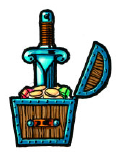
Delver's Guild
This guild of 3 years has quickly become one of the most powerful in the city when adventurers began returning with great treasure from Ptolus' underground catacombs 7 years ago. The Delver's Guild is basically a support network for adventurers, who provide information about job opportunities pertaining to underground exploration and an extensive collection of subterranean maps. Membership is a fee of only a few gold pieces a year for the lowest levels, and as such most delvers belong the Guild.
There are four ranks: Associate Guildsman, Guildsman, Master Delver, and Grand Master, with the last two open only to people who've served in the guild a set amount of time. Membership costs increases with rank, but comes with increased privileges. Even the lowest-level members gain access to a discount at Ebert's Outfitters (shop catering to delvers), and reports. Guildsmen gain this, plus access to guild libraries and passwords to waystations, secret chambers in underground regions stocked with food and simple supplies. Master Delver grants voting in guild actions and election of the Grandmaster Delver, plus retrieval insurance (if you're lost or killed while delving, the guild will send an adventuring team to rescue you or your body for resurrection). Grand Master level grants the right to claim staking, where a region of the dungeon can be cordoned off to all but themselves and allowed parties, and the Guild pays other guildsmen to guard the entrance.
Naturally this guild is very relevant to PCs interested in dungeon exploration. In my campaigns my party allows paid for Guildsman level and joined them. There's no good reason not to do so.
The Fallen
An alliance of demons and devils (the differences matter less in the campaign setting than others) who followed Raguel into Praemal, the Fallen are considered the "young demons" of the world (Galchutt being the "old demons"). Two hundred years ago they arrived, and relocated to the city of Ptolus, waiting for their leader's eventual decision of whether to free the Galchutt or fight them. Their headquarters is the Dark Reliquary in the Necropolis, where the local Forsaken welcomed them with open arms. Many of the Fallen regularly take humanoid shape (or alter themselves with external magic if they can't do so naturally), enjoying the increased agency this grants them to operate in Ptolus proper. Raguel commands them to not draw the city's attention, but they need to feed upon mortals every so often and kidnap them from villages outside the city (or the city's unwanted) to take back to the Reliquary to feast upon.
Raguel's lover, Lilith, is a demon princess who favors freeing the Galchutt and works with the chaos cults to bring about the Night of Dissolution. She has the support of many of the Fallen. Raguel has learned that the only way to contact the Elder Gods is to travel along the Seven Jewels of Parnaith. His agents has obtained Parnaith's Mirrored Sphere to undertake the journey, but he does not do so now for fear that Lilith will perform a coup against him in his absence. To this end he looks for mortals to act in his stead.
Raguel and Lilith are very powerful entities. Raguel is a deity in his own right, but uses stats for a Solar angel but is Neutral alignment. Lilith is a succubus with 19 levels in Sorcerer.
Raguel and Lilith:
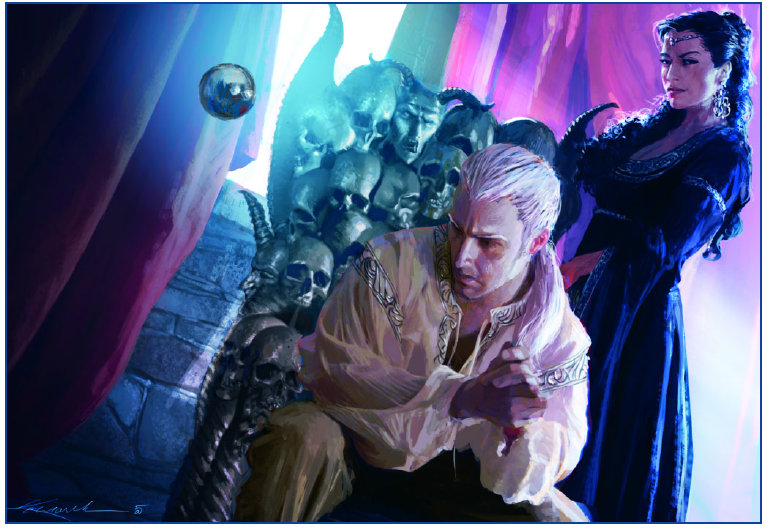
Fate Weavers
The Fate Weavers began as a school for fortune-tellers and sooth-sayers who were friends of the legendary hero Abesh Runihan. Now operating out of the Rivergate district, the students and teachers practice a form which they believe can read the destinies of others that only a "special few" are born with. Regardless, most genuine spellcasters do not detect any magic from their readings, not to mention that magic which can accurately tell the future is difficult to master. Most folk in the city do not respect them except for the truly desperate and folklorists who can't afford the services of genuine spellcasters.
The Fate Weavers hope to use their talents to shape the future for the better, and as such secretly support the underground republican movement which hopes to overthrow the Commissar and bring rule by the people, for the people. They also have an adventurer living in the school who once spoke with a dying Elder Elf and wears his armor as a sort of honor. He knows more than anyone else in the city about the Urthon Aedar (last remaining elder elves), but will only tell of them to those who convince him that their intentions are good.
Cook leaves the Weavers' genuineness open to DM whim. If they're the real deal, Fate Weaving is not magic but a cross-class skill based off of Wisdom which can tell a character if they're on the right path with a successful roll, with difficulty based upon the topic's specificity.
Forsaken
The most reviled group of people in Ptolus, the Forsaken are living mortals with an unhealthy fascination with the dead and undead. They convene in the Necropolis and consort openly with dark gods and the Fallen. They share their home with the Fallen in the Dark Reliquary, helping their fiendish patrons with various tasks in exchange for protection. Many of them worship the Galchutt, and crossover with Chaos Cults is common. They frequently disturb the graves of city folk to use their corpses for necromantic magic or sexual pleasure, which enrages the citizenry and the Commissar has made grave-robbing a crime punishable by death as a result.
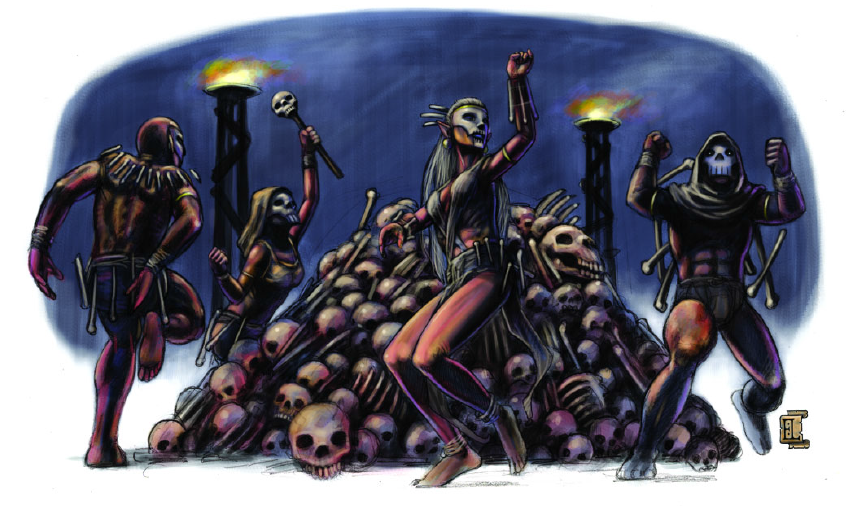
The Guilds
Aside from the more extraordinary guilds related to typical D&D stuff (Delver's Guild, the Inverted Pyramid mages' guild, and the Longfingers Thieves' Guild), Ptolus is home to plenty of mundane trade guilds. Most of them are of various trades, the Brewers' Guild, Cobblers' Guild, Textile Workers' Guild, and the like. Normally they won't be of much use in typical campaigns, but Monte suggests that they can become embroiled in adventures. Say, the Glassblowers' Guild is hired to fashion the framework for a magic item. The Sorn-Ulth Orcs in the Dungeon secretly commissioned it via intermediary to create a fell magic item, and murder the craftsman to cover their tracks, thus prompting the Guild to hire adventurers to track down the killer.
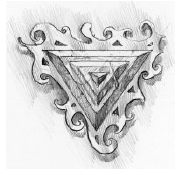
Inverted Pyramid
Although it came to public view after the passing of the Edict of Deviltry, the Inverted Pyramid existed since before recorded history gathered the most powerful sorcerers and wizards together to pursue their art separated from worldly concerns. They have been a foe of the Church of Lothian since the Empire's founding, and during the Days of Blood they tirelessly worked to rescue persecuted mages and relocate them to secret safehouses. Additionally they gathered plenty of arcane texts to keep out of reach of zealous clerics. When Commissar Norrid offered Ptolus as a sanctuary for mages in 615 IA, the Inverted Pyramid moved its headquarters to the city, where they remained ever since.
quote:
Although no longer openly antagonistic toward the Church of Lothian, the Inverted Pyramid fears that at any time the religion could fall into the grip of its more right-wing clergy and oppose arcane magic again. While such an event seems unlikely, this paranoia keeps the Inverted Pyramid watching the Church of Lothian closely and with great distrust.
With the conceits of a pro-democracy movement and other "modern" social constructs, I kind of wonder what the left-right spectrum of Tarsisian and Church politics looks like.
The Inverted Pyramid's headquarters is also its namesake, a floating, upside-down pyramidal structure above the streets of Oldtown. From the outside it is invisible, and most citizens have no idea where it actually is. Its most elite members, called Masters, are some of the most powerful beings in the world and average around 20th level.
Membership in the Inverted Pyramid is available to arcane spellcasters of 8th level or higher, and invitations are sent to those of 10th level and higher. Membership is a yearly due of 2,000 gold pieces. Initiates must honor reasonable requests of adepts and masters (higher-ranking members), and unreasonable use of this privilege can earn a fine. Members are also granted living space in the headquarters, and to maintain a laboratory or workshop. They also have the greatest collection of spells in the world, with all known spells recorded, and new ones are constantly made and shared with members. They also have a great library on history, the planes, religion, and other topics (+5 bonus on Knowledge checks when undertaking research). They also get a 20% discount on magic items bought from the Dreaming Apothecary. Membership is secret, but every member is given an invisible charm which floats aside them which can only be seen by others with said charm (so that members can identify one another). The Pyramid can deactivate charms should a member die or have the charm stolen.
Dreaming Apothecary
In reality this is an extension of the Inverted Pyramid, but most don't know that. Most people in Ptolus have heard of it, but regard it as a myth. Supposedly it's an organization which can only be contacted via dreams, and can provide someone with anything provided they can pay the price. In reality it's a group of spellcasters who make magic items to order, and they pretty much have a monopoly on Praemal's trade in higher-end and permanent magic item market (potions, scrolls, and wands are fine and not seen as a threat).
The Apothecary has no storefront or headquarters in the city. They have representatives who scout out the right people, and if they're interested are provided with a bronze coin to place under their pillow or bed at night. The Dreaming Apothecary contacts the person in their dreams, during which they make a transaction. The dream becomes subject to detect thoughts and discern lies spells, with no saving throw allowed due to the coin's magic. The seller ascertains if the prospective buyer has the funds. If they have the money to pay, then it's gone once they wake up and they receive their magic item in two weeks or double the crafting time (if made) or the next morning (if the Apothecary has one on hand). The buyer will find an exact portion of their funds missing, even if locked within the safest of vaults. It arrives in a package via a courier who does not know what's inside or who sent it.
People who try to get around these restrictions, via proofing themselves against divination or storing their money in a place unreachable by teleportation magic, will simply not get their item.
It is common knowledge among spellcasters that people who try to cut in on the Draming Apothecary's business end up meeting dire fates: mages are polymorphed into animals, rendered brain-dead, their shops burned to the ground or disintegrated. Those who sell used magic items, potions/scrolls/wands, and for their own personal use or that of their allies are exempt.
Keepers of the Veil
This is a knightly order dedicated to the destruction of undead, particularly sapient spirits. The Von Tibbitz family has a knack for seeing incorporeal entities, and although its not a hereditary position, they have functioned as leaders for over 700 years. In recent times they relocated their headquarters to Ptolus, along with much of their resources, to deal with the undead in the Necropolis. Due to this they are a constant thorn in the side of the Forsaken and the Fallen, and any other groups which deal in necromantic rituals. Their base of operations is the Siege Tower, a building built into the Necropolis' wall. They are pretty much on a war footing, and they don't have the manpower yet to take on the Necropolis' factions all at once.
Sire Beck Von Tibbitz and Phadian Gess.
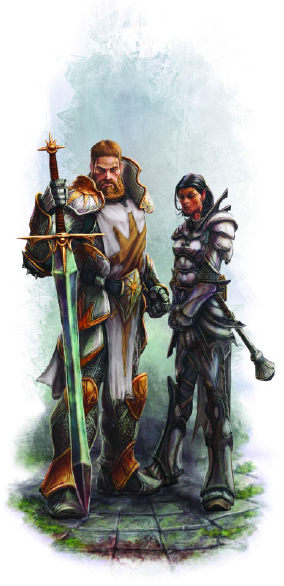
Killraven Crime League
Killraven is the newest scene in Ptolus' criminal underworld, and is notable for bringing mostly outsiders to the city as opposed to subsuming existing factions into her organization. Killraven is an annis hag in disguise with big ambitions, hoping to eventually replace the Balacazars, the Inverted Pyramid, and the Vai in their respective fields. She has become a formidable threat to all of them due to her secret alliance with Emperor Segaci Fellisti, who provides her with funds. She also secretly funds the Shuul, the church of Teun, two of the largest technologist organizations, who do not know the true connection to this figure. Unlike the Balacazars her group is loosely organized throughout the city, and members don't even have an official name for their over-arching group (they simply refer to themselves as "us," "all of us," and the like). Killraven herself lives in a fortress in the Undercity guarded by a private army, and she has an efreeti noble bound to her service.
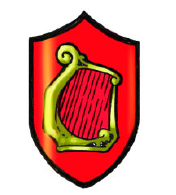
Knights of the Chord
This is a small knightly order dedicated to upholding ideals of freedom and protecting the innocent. They are officially recognized by the Empire but receive no funds from the Commissar (unlike the other knightly orders). Many of their members are bards with heavy training in martial skills, and have an alliance with House Kath bound by an ancient oath.
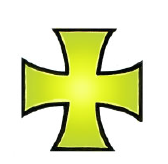
Knights of the Golden Cross
The iconic example of everything knightly, this ancient organizations dates before even the times of Eslathagos Malkith, and have long opposed evil in all its forms. They are a purely altruistic organization dedicated to the common welfare, and oppose the machinations of House Vladaam, the Fallen, and other evil factions. Although they don't always do so openly in the case of the former. They secretly revere the Elder Gods, and possess great records of the world's hidden knowledge. They are very small in comparison to the other knightly orders, having only 9 members, but each of them is powerful in their own right (averaging 10th level). They are led by Kaira Swanwing, an elven Rogue/Wizard who hopes to counter the increasing worry and pessimism the fight against evil is imposing on them. She believes that a great victory for the cause of Good will help turn this around. They work with the Keepers of the Veil from time to time.

Knights of the Pale
This knightly order specializes in combating supernatural threats such as demons and evil spellcasters. They are an exclusive and discriminating organization of 16 knights who revere Lothian and his saints, and receive good funding due to their Imperial Charter. Dierna Hillerchaun is the knighthood's leader and she serves as one of the Commissar's 12 commanders.
We also have stats for two prominent knights, Brig Stoneheart (a permanently enlarged dwarf) and prince Ironheart, a Paladin whose skin has a flexible layer of iron bonded to it.
Knights of Shadow
Not a proper knighthood per se, the Knights of Shadow are comprised of Ptolus' influential who hope to enact change in the Empire. They are merchants, physicians, constables, sea captains, and other members of the middle class. They are a secret organization of coded words, symbols, and handshakes who control trade via bribery of officials and pressuring for certain laws to be passed or not passed, banning the import of certain products, and other economic means. Currently the group is split in two: one faction sympathizes with the republican movement and wants to overthrow the Commissar and the government of Tarsis, the other wants to preserve it in the name of stability of the world's greatest civilization.
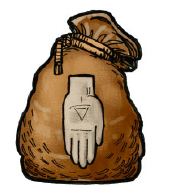
Longfingers Guild
This old thieves' guild once commanded great respect in Ptolus, but they are now a fading star as more people find it lucrative to work for the Balacazars or Killraven. Guildmaster Thief Haymann Knapp is the stereotypical "honorable thief," who misses the old days that banded together and helped Ptolus' poor children by teaching them to obtain things they could not otherwise come by. Nowadays the criminal factions work for depraved individuals and hurt, oppress, and kill society's disenfranchised (notably the Balacazars).
The Longfinger's Guild is mostly Neutrally-aligned, and are a potential organization for Rogue PCs to join. They have a sprawling underground headquarters with an ever-changing obstacle course to help train new members and keep experienced ones on their toes. "A relaxed thief is a dead thief" is a favorite saying of theirs.
Malkuth
The Malkuth are an order of angels who voluntarily came into Praemal to help fight the evils in the world, notably the Galchutt. They are based in the Pale Tower in the city of Ptolus, a 300 year old structure in Oldtown, usually keeping to themselves in meditating when not on some mission of grave import. They also have many aasimar and half-celestials among their number, the very children and descendents of said celestials. Their most well-known member is a half-celestial named Asoka, who is one of the Twelve Commanders. She is not their leader (who is a solar named Sephranos the Winged King), but often leads them in his absence.
Asoka:
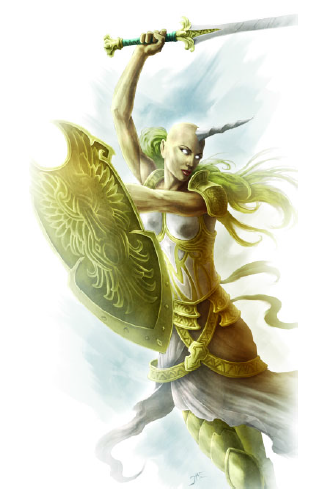
Naltegro Suun
This secret order is comprised of 13 assassins, who are strangely non-evil. They are contract killers, true, but they demand proof that their intended victim deserves whatever fate to bring upon them; in fact, they are often hired not to kill, but sometimes to send a violent warning or destruction of property. Those who try to trick the Naltegro Suun find themselves visited upon an appropriately "just" punishment. They know of how easy it can be to fall into evil, and are careful to separate the emotions of vengeance and similar ones from their business.
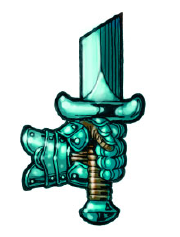
Order of Iron Might
120 years ago two warriors made a bet by Arbon Sevolve. Sevolve contested that an organization for swordfighters and mercenaries in the same vein as the Inverted Pyramid would prove successful and popular. He won the bet, as gladiators from the city's arena and mercenary bands flocked to join it. The Order of Iron Might is a warrior's guild dedicated to finding an securing employment for its members. Their headquarters, the Citadel of Might, is located near the Arena in Oldtown, and serves as a hiring hall in addition to temporary living quarters and a grand courtyard to duels and physical training. They currently have more than 400 members, and have close ties with House Khatru.
Membership fees are 20 gold pieces to join plus 10 per year, but benefits include training, shared contacts, and reduced prices of weapon and armor repair.
Pactlords of the Quaan
Very few people have heard of the Pactlords, and this is how they prefer it. Comprised of nonhumanoids threatened by the rise of elves, humans, dwarves, and similar races, an assembly of influential monsters forged a magically-binding pact to work together against this common threat. The organization draws upon all manner of intelligent species, from aboleths, dragons, manticores, and aberrations. They only accept individuals, not groups, for entry, and frequently use dim-witted giants as minions (who are called Pactslaves). In Ptolus the Pactlords sponsor the largest slaving organization, the Ennin, who operate out of a warehouse in the Docks.
Their headquarters is an ethereal island known as the Quann, a swampy marshland where its leaders congregate to make decisions. In there is the Black Manor, their residence, and a gargoyle-covered fountain functions as the magical foundation for the Pact.
Pale Dogs
This street gang controls the Warrens, Ptolus' poorest neighborhood. They are led by a mysterious person known as Jirraith, and nobody within the group knows anything about him beyond his name (or if he's even male). In truth, Jirraith is a doppelganger who uses the gang as a sort of proving grounds for other more prominent criminal factions. Those experienced in subtle murder he passes off to the Vai; others go to the Balacazars. The rest are kept in the Pale Dogs, who live short lives and turnover rate of members is high. They shave their heads and taint their fingernails and sometimes teeth black as a kind of uniform.
The Shuul
This new group in Ptolus is dedicated to restoring the reign of science and reason in the Empire, and are staunch supporters of Law. They are more commonly known as masters and innovators of technology, and do all they can to reserving the declining trend by gathering the Empire's greatest technicians and machinists to the city. They have no opposition to magic, and many of its members are arcane spellcasters and clerics. They also have the largest storehouse of firearms, gunpowder, and steam-powered machines in Ptolus, and they sell firearms out of the Smoke Shop in Midtown. Regulation is heavy, as the Empire requires a license for anyone who wishes to own such a weapon. They are working hard to found a technologists' guild, building a Tower of Science in Oldtown, and work hand in hand with the church of Teun and monitor schools for bright-eyed young students skilled in mathematics and science to recruit when they grow up. They don't like the Church of Lothian for its suppression of "heretical" texts which contributed to great loss of knowledge.
They do have a dark secret. For one, their efforts require a lot of money, and the organizations' leadership turned to Killraven through Segaci Fellisti to gain much-needed funds. Additionally, some of their greatest scientists are secretly zaug in disguise, who are just as adept with real technology as chaositech. Normally their sinister reputation would make them pariahs, but they helped in so many scientific breakthroughs that they found acceptance even when discovered.
The Shuul create and sell unique equipment, from leather jacket armor, goggles which guard against bright lights, and "potion pills" which can be quickly swallowed.
Shuul Agent:
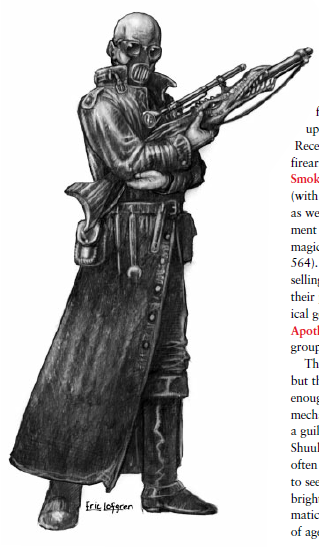

Sisterhood of Silence
This all-female vigilante task force is notable for its monks who've taken vows of silence. They are even more feared than the City Watch, for they are beyond reproach when it comes to resisting bribery, blackmail, and corruption. In 690 IA Ptolus was a very dangerous place to live, and the Commissar decided to work with them rather than against them once they proved their competence in preventing crime. They are careful not to break Imperial laws, and captured criminals are turned over to the City Watch. In addition to skill in unarmed combat, they have great skill in wielding with crossbows enchanted with Stunning Bolts (created by the Dreaming Apothecary exclusively for them, DC 21 Fort save or stunned for 1d4 rounds). They also wield greathammers in battle, which they are proficient with. They employ male eunuchs as Speakers, who make spoken declarations on behalf of the order.
The Sisters despite their vow do make use of nonverbal communication, and their membership comes from the ranks of young girls from the streets who have no home or family to return to (or on the run from abusive parents). Their headquarters is the Priory of Introspection, a training ground.
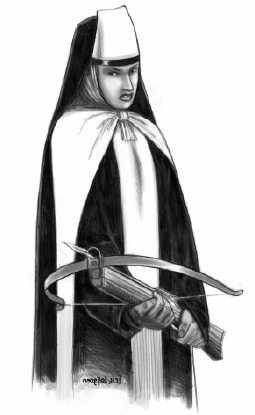

Sorn
Their name coming from the Abyssal word for "breath," the Sorn are a new criminal group in Ptolus backed by Killraven and the Shuul. They are comprised entirely of arcane spellcasters who use their magic to act as spies, assassins, and enforcers who carry out their deeds while wearing masks or under disguise. They are grouped into independent cells who known little of the others' activities, and have very different duties. They are enemies of the Inverted Pyramid, and rumors on the street say that the two are preparing for a clandestine magical war.
Soul Riders
A dozen mortals are born with the rare gift to transfer their spirits into the bodies of other creatures, controlling their actions entirely like a puppet on strings. They have no form, not even an incorporeal one, in this state and can only be slain or imprisoned via a handful of magical spells (only a wish or miracle can fully destroy them). They can glean all the knowledge and memories of a victim, giving them a very expansive collection of information over the years. The Soul Riders are sociopaths, and they only work together for the eventual goal of world domination. To that end they manipulate events in Ptolus to secede from the Empire and become a city-state ruled by people they control. On that end they hate the Fallen and Chaos Cults, because their goals will destroy the very city they want to rule. They have yet to possess any of the city's most powerful people (Menon Balacazar, the Commissar, etc) who know of their existence and protect themselves with spells from mental domination.
Urthon Aedar
The Urthon Aedar is an Elder Elvish name meaning "Wandering Judges." They rarely appear except as armor-clad figures who appear just as suddenly as they vanish after completing some task. They never speak or leave behind clues as to why they do what they do. Their origin lies during the days of Ghul, of those few elves who managed to resist his torture and transformation into Harrow elves. Enraged, Ghul cursed them with visions of the future so that they will know of their demise and see a world ruled by him. What Ghul did not know was that he would fall, and this gave the elves hope throughout these horrible times. When Ghul's fortress fell they used the Entropy Sphere to travel to Dreta Phantas, the Dreaming City, and from there they trained in martial and magical skills to better control the events of the world which they'd see coming. Their ultimate goal is to restore this city to its rightful place, as well as safeguard the well-being of elvenkind.
Urthon Aedar armor is a unique magical suit of full plate armor with no armor check penalties, arcane spell failure chance, or maximum dexterity bonus. All Urthon Aedar are extraordinarily powerful elder elves, ranging around 18th-20th level and have levels in Eldritch Knight (a fighter-mage prestige class).
Urthon Aedar in full plate:
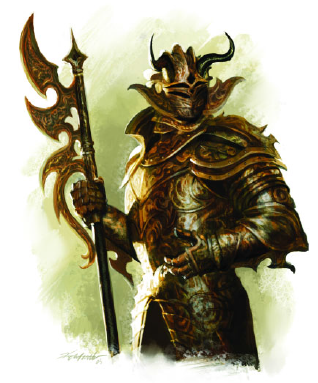
The Vai
The Vai are a death cult which has evolved into an assassin's guild in Ptolus once they realized that murder-for-hire was a lucrative market. They are little-known in Ptolus, of whispered rumors of an all-powerful organization with eyes and ears everywhere. In truth, their membership numbers a mere 35, of independent cells of 2-4 who have little knowledge of what the others are doing. They have ties to the Deathmantle Chaos Cults and the Balacazars, and as such oppose Killraven and the Sorn.
The Vai dress in all-black clothing and a face mask while doing their deeds, and are never caught without poisons of various kinds hidden on their persons. Their headquarters, the Chapel of Final Resolution, is located in a secret room beneath the streets of the Warrens. The leaders of the guild are the Twin Lords Keper, who rarely leave the chapel and only take the most extreme of assignments. The Vai are also bound to kill at least one living creature day, even as small as an insect. However, most do try to kill at least one intelligent creature a month.
The Viridian Lords
This organization of rangers, barbarians, and a few druids exists primarily in Palastan, and their word is law out on the open road. They have no significant presence in Ptolus except for the Palastani residents, who regard them highly. Viridian Lords have no hierarchy, and they're known to bond living plants to their flesh in a magical process.
The plant-bonding is a series of 3 feats, which grant a natural armor bonus (Viridian Flesh), cast pass without trace at will and speak with plants once per day (Viridian Essence), and detect plants at will and +4 on saves against plant-related spells and monster attacks (Viridian Nature). Overall the feats are kind of weak and won't come up often.
Monte Cook ends this chapter with a brief on how to use the organizations in games. Basically as allies to work with or join, foes to fight, and a list of some organizations the PCs might want to join (Order of Iron Might and Inverted Pyramid for fighters and arcanists, the knightly orders, the Longfingers Guild for rogues, and the Delver's Guild for dungeon-delvers to name a few). Overall nothing ground-breaking.
Thoughts so far: I really like this chapter. The organizations receive varying levels of detail, and some I feel receive too few support (Knights of the Chord are tailor-made for bards, for example), and I would have liked to see an entry on the Conciliators (the Inquisition of Lothianites), and the goodly knightly orders overlap a little too much (what's so different about the Keepers of the Veil and the Knights of the Pale?), but those are my only real criticisms. My favorite entries include the Inverted Pyramid and the Dreaming Apothecary (who provide a nice explanation on how expensive magical items are safely sold and an alternative to the omnipresent "magic item shop with awesome gear"), and the Shuul, who I always found to be really cool.
Next time, Chapter 7: City by the Spire, a starting guide to the city proper!
City by the Spire
Original SA post
Chapter 7: City by the Spire
This chapter is a general layout of the city, covering information and topics not confined to any one district. Chapters 7 through 18 cover the city proper, not including the dungeon environments below (those are chapters 19 through 23) or the Spire itself (chapters 24 and 25).
Cook starts off by describing the city’s mood. Well, it is first and foremost a concentration of all the interesting stuff in the world. Nowhere else will you find a fortress of angels and aasimar, nor an expansive underground dungeon complex and adventurers seeking its wealth and glory. Despite having a reputation as an Imperial backwater, the Commissar and the Empire at large tolerates this arrangements. Adventurers in general are known for their mighty magic, violent lifestyle, disregard for the law, and containing various unsavory sorts such as tomb-robbing rogues, mercenaries, and arcanists. By coming to Ptolus, other nations don’t have to put up with them, plus their skills are useful in bringing wealth to the city and handling the threats underground.
Ptolus is also one of the most cosmopolitan cities in the world. Whereas most nations are overwhelmingly human (90%+), Ptolus’ population is only 70% human with a smattering of other races. It has served as a haven for worshipers of non-Lothian religions and arcane spellcasters. Due to the Brotherhood of Redemption’s efforts, more than a few monsters are official city residents (and thus citizens of the Empire).
Ptolus’ population is around 75,000 people, counting only official residents (no ratmen, skulks, or dungeon-dwelling entities). Were one to count the underground communities, it would add about another 5,000 (not counting the dark elf cities), and another 1,000 if one were to count the undead and fiends in the Necropolis. The most racially diverse district is Midtown, with elf, centaur, litorian, and halfling neighborhoods. Orcs and lizardfolk don’t receive warm welcomes and tend to live in the Warrens (alongside other undersirables). Dwarves tend to congregate in the Guildsman district, while houses of worship of deities popular to various races have at least some representation in the Temple District.
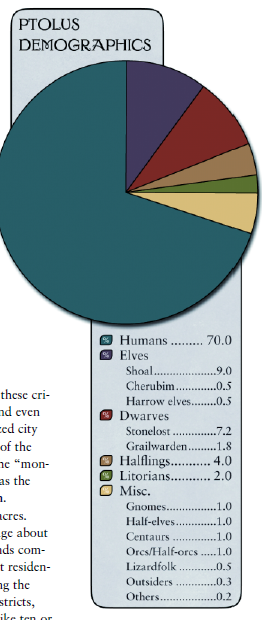
In regards to character classes, the vast majority of the city has levels in Commoner, with Expert and Warrior being the next 2 common ones, and more than its fair share of Aristocrats. In regards to PC classes, there’s 5 times as many of them than normal, because so many people with these classes come to Ptolus which is a more welcoming environment. Barbarians, Druids, and Rangers are still quite rare.
City Map, with icons representing districts. Western districts are Noble’s Quarter, Oldtown, Rivergate, and South Market. Midtown, Temple District, and North Market are in the relative center. The Necropolis, Warrens, and Docks are in the northeast, while the Guildsman District dominates the southeast:
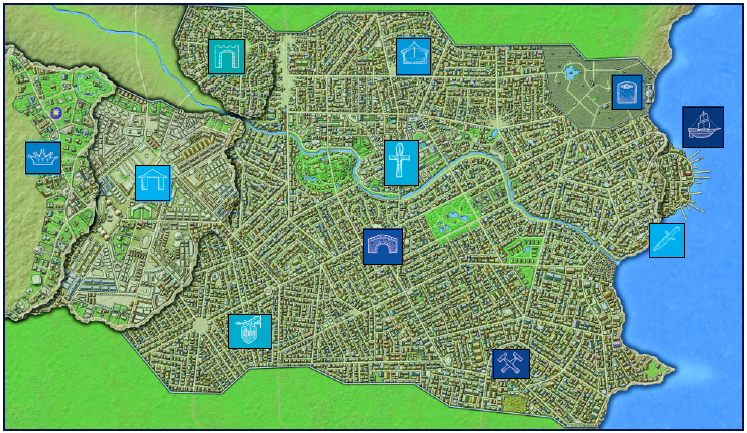
Government
Ptolus is part of the Empire, and thus ruled by a Commissar, or regional governor who administrates a city or region in the Empire’s stead. The current Commissar is Igor Urnst, and elderly general and war veteran who’s held his position for 18 years. He’s quite popular around the city, in part due to his military victories in the Gnoll War, and is willing to accommodate the needs and desires of Ptolus by delegating more power to the City Council (which is comprised of nobles, guildmasters, and other influential individuals). He also has a group of advisors, the Twelve Commanders, to coordinate efforts in times of crisis. This gives the impression of a man willing to listen to alternative views and experience in matters outside his expertise, as opposing to a supreme ruler making all of the decisions. In reality, Urnst has trouble admitting to mistakes and this has caused him to butt heads with the Holy Emperor more than a few times, especially in matters regarding religious liberty for minority faiths. This most recent move has made Urnst all the more popular among Ptolusites, so there’s a political aspect to it, too.
Commissar Urnst:
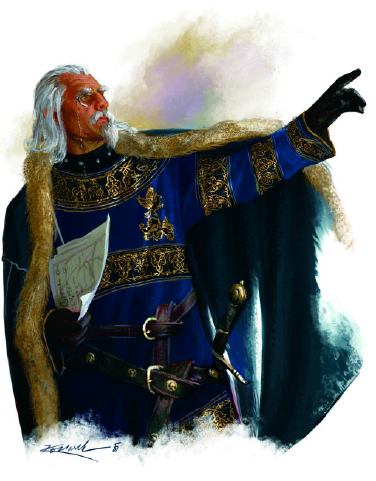
The current Council has 25 members, along with a representative from each noble house. Cynical residents refer to it as the Council of Coin for focusing mostly on economic issues and being comprised of the upper class, although the Council prides itself of not being governed by the rabble.
As for the Church of Lothian, priests are technically members of the Imperial government. The Church has a strong presence in Ptolus ever since Holy Emperor Cheroboth Ylestios built the Holy Palace in the Noble’s Quarter in 657 IA, where the Prince would live until he ascended to the title of Holy Emperor himself. This was done to quell the religious upheaval in Ptolus due to the influx of minor faiths, and it has been quite successful. Now it is also home to both the Prince, Kirian Ylestios, and the current Holy Emperor, Rehoboth Ylestios. Church officials can command the City Watch to a limited extent, and have special privileges under the law, affording them a great deal of influence.
As for law enforcement, the City Watch are the primary peacekeepers of Ptolus. They are less akin to a modern-day police force and have more in common with the soldiers maintaining order in an occupied city. Their primary goal is to “keep the peace,” and as such have the power to arrest anyone for any reason (although they take care not to arrest the “wrong sorts of people”). They are authorized to use deadly force if need be, although they spend more time deterring crimes as a preventative force and breaking up fights than actually investigating wrongdoings in-depth (that’s the jurisdiction of the courts and various intelligence agencies), with the exception of criminals with a history of repeat behavior. They are very competent at their jobs, knowing the ins and outs of organized crime groups, and regularly scout areas where trouble can brew (such as abandoned warehouses and alleyways). They are typically equipped with chainmail armor (with trademark blue tunics), along with masterwork weapon and some normal ones (typically battleaxes and spears and light crossbows). A few guards per watch house are trained in the use of firearms and have dragon pistols instead of crossbows. A captain of the guard wears full plate armor with a special insignia and yellow sash.
Watch houses are divided into precincts based upon city district, with the exception of the Warrens and Necropolis. They serve as central headquarters, barracks, and jailhouses. Various bells on posts are placed throughout the city to be rung, which indicates trouble and summons watchmen within hearing distance. Care has been taken to reasonably distribute them.
Typical guards are 2nd level warriors, while constables are 5th level fighters. The average captain’s a 10th level fighter. There are some special guards with spellcaster levels here and there as well for handling certain types of crimes.
Soldiers around the fortress of Dalenguard are a specialized fighting force known as the Commissar’s Men, and thus the typical member has 3 levels in Fighter.
A spellcasting branch of the Watch is known as the Goldshield, arcane spellcasters who patrol high-traffic areas such as the North and South Markets. They use divination spells to catch spellcasting and invisible thieves and criminals, and their headquarters is based in Oldtown.
The Imperial Eyes are an organization of spies weeding out threats to the government. In Ptolus they serve under the Commissar, and managed to infiltrate numerous organizations, notably the Balacazars, the Church of Lothian, and various noble houses.
The Economy
Traditionally Ptolus was a coastal trade city with some mineral desposits in the mines, but over the last seven years it has experienced a boomtown effect of adventurers uncovering great riches in the Dungeons beneath town. It’s assumed that any item priced 100,000 gold pieces or less is available (if not sold openly). Magic items, however, are highly restricted and go through the Dreaming Apothecary or Myareth’s Oddities in the case of permanent ones beyond the wand/potion/scroll combo. PCs can easily sell up to 150,000 gold pieces worth of goods at any one time, and an equivalent amount of a certain item is up for sale at any one time as well. Certain goods are illegal (such as some drugs) or heavily restricted (a license to buy firearms or cast certain spells within city limits).
The city still uses the copper/silver/gold/platinum standard. Silver’s used the most and is the standard rate of exchange, gold is used among the more affluent, while platinum coins are rare and some common shops refuse to accept them. The Empire has been developing letters of credit, basically paper money worth a certain amount. It is mostly used among merchant companies and has yet to catch on with most people, but the city’s wealthy use them because it’s inconvenient and dangerous to carry around thousands of gold pieces at a time. The Inverted Pyramid, in defiance of Imperial law, is also minting its own triangular “mage coins” which can be teleported into the hands of the last person who touched them (making them perfect for storing in secure vaults).
City Layout
Even without its most recognizable feature, the City by the Spire is a very vertical place. The westernmost section of Ptolus is also its highest, the Noble’s Quarter, from which one can look out to the rest of the city. As one heads east the elevation decreases, right up to the docks right by the edge of the Whitewind Sea in a grand waterfall. The King’s River flows through the center of town before emptying out into the bay. Ptolus stretches about two miles east to west, and one can easily tell the time by the position of the Spire’s shadow cast over the city.
The wall surrounding Ptolus was originally built in 587-590 IA. It restricts access from the north and south, and since the city has never been attacked many residents do not take it seriously. Guards patrol the walls along with towers, but they use the positions to look into the city and not outward.
Five gates provide access into Ptolus, three on the south wall and two on the north wall. The gates leading into the north and south markets are the major thoroughfares, with the other ones on the south newer additions for the sake of convenience. The minor gate in the north wall is the Old City Gate. Guards stop people at each gate, and people can only enter the city by displaying Imperial Identification Papers and a 2 copper piece toll per person (more for livestock and cartloads of trade goods). It’s a daily toll paid only once, although people don’t need to pay a toll to leave the city. Merchants must pay a 5% levy of the worth of their goods when transporting goods. Trying to get around this can result in fine and seizure of goods (they’re treated as smuggled items and contraband).
We also get a list of some major thoroughfares Ptolusites use to get around town, with the Emperor’s Road being the one which connects Ptolus with Tarsis and winds through Oldtown all the way to the South Market.
As for the Spire itself, well most Ptolusites don’t know much about it, and everyone realizes that it’s too impossibly tall to be an act of nature. It reaches 3,000 feet into the air and is composed mostly of dark grey rock, which grows blacker the farther one ascends. It has a sinister reputation among residents, who attribute all sorts of nefarious origins (demonic sculptors, the corpse of a mad god, etc), along with equally tall tales about the fortress at its top (which most people can’t see and some even doubt there’s one at the top). People do know about Goth Gulgamel, but only that it was Ghul’s fortress, and even then most only know him as an evil conqueror and nothing more. Additionally, no explorers or mages who ventured up the Spire past a certain point have ever returned or been seen again. It’s common knowledge in Ptolus that bad stuff happens up the Spire, and most capable of flight give the Spire a wide berth.
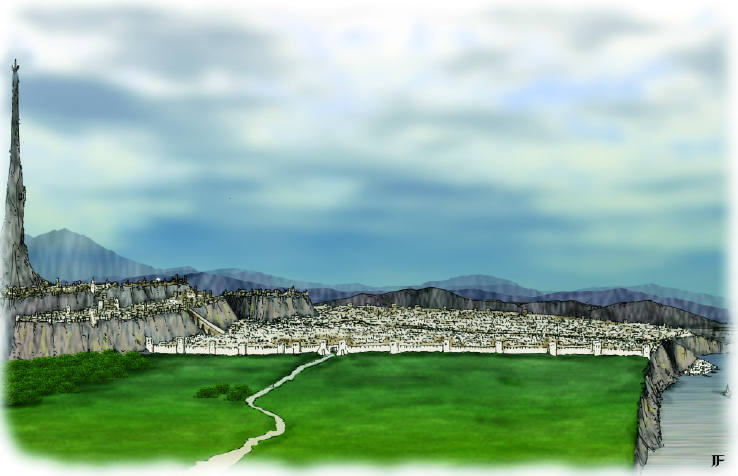
Here’s a section of the chapter I like, as it gives a feel of an average morning day in Ptolus better expressed through a quote:
quote:
It’s the smell of the city that gets to you first. No matter where you stand, you probably smell the rain, because it likely either just finished raining, is just about to rain, or is raining now. The odors of damp clothes and people, moldy wood, wet straw, rain-slicked stone, and burning wood and coal mix together to create a unique aroma. But if it’s not raining, this smell mingles with the odors of cooking food, domestic animals, garbage, and sewage. The latter two aren’t as bad as they could be; the sewers in Ptolus, as in most large Imperial cities, are quite efficient, and the constant rain keeps their contents moving. After the smell, it’s the noise you notice. People aren’t shy about shouting to their neighbors out their windows, or calling down the street from their doors. Tolling bells and sounding horns signal various religious rituals from the Temple District, and entertainers sing, play instruments, and tell jokes in the street. Street orators attempt to inform and persuade those who will stop to listen, while bellringers shout out the news of the day for those too busy or too ignorant to read one of the many local broadsheets. Behind all those sounds, in many areas of town you can hear the rushing waters of the King’s River through the ravine that cleaves the city in two, or the crashing of waves on the Cliffs of Lost Wishes at the city’s edge. No matter where you are in the city, you can look up and see the Spire, unless it’s raining so hard that the sky is just a swath of grey. As you look west, the city rises. To the east, it falls until it reaches the cliffs.
The skies of Ptolus are unlike anywhere else in the Empire. In addition to the Spire, one could see hot air balloons owned by noble families, mages under the effect of flying spells, adventurers and druids riding upon winged beasts, and dragons and demons might be spotted across the horizon on some errand. For normal transportation most people walk, but there are carriages for hire easily reachable by the average citizen, and the wealthy own their own private carriages. As for communication, couriers are very common, along with Shadow Sendings (magical missives which take the forms of black birds which carry a pre-recorded visual and/or verbal message to a specific indivudal). Town criers are part of the Bellringer’s Guild and paid to inform people of news, usually vital bits of information by the Commissar.
On the more magical front, Shadow Sendings are managed by House Sadar, and despite its sinister connotation it’s merely an efficient and popular use of sending messages to people not at a fixed location. The Inverted Pyramid also uses thoughtstones, which are kind of like mobile phones in that they allow people to chat with one another over a central network. They are not for sale, given only to Inverted Pyramid members and influential people in the city.
Ptolus is also home to several printing presses, and the second most common way to spread information is via newspapers (more commonly known as broadsheets). Ptolus has dozens of publications, and there is no code of journalistic ethics to verify the truth. On the other hand, there is no freedom of the press, either, and the Commissar has (and will) shut down papers deemed a threat to public safety.
The Courier is the most prominent newspaper and focuses on important events around the Empire. It has a pro-Empire bias it tries to hide under a “fair and balanced” front.
The Guilder focuses on news and gossip pertaining to the city’s guilds. Ownership changes frequently whenever a new guild takes it over, so biases can change suddenly.
The Market Voice is largely print advertising for various businesses in the North and South Markets, and focuses on economic news and information.
The Midtown Partisan is a trashy gossip rag which focuses on scandalous dealings of the nobility, and is not shy of making things up to increase sales. It’s secretly funded by House Rau to make the other houses look bad, and their staff and location are secre. They’re the National Inquirer, basically.
The Noble Record is more high-brow, in that it reports on entertainment-related news and its fictional retellings of people are more ‘fanciful’ than slanderous.
The Ptolus Herald is secretly funded by the Republican Movement, which is shamelessly anti-Empire and known for its scathing editorials against the city government. They City Watch has raided it numerous times, but it always starts up again.
The Undergrounder is a broadsheet which focuses on dealings in the criminal underworld, and as such is not widely spread. It recently begun reporting news related to the delver community and the Dungeon.
Our last section is a legend for the future chapters on how to read the entries, explaining what certain symbols mean, what type of information is found in this entry, and so on. It’s quite a useful guide. You have entries for things like district rumors, the average citizens you might see on the street, as well as a map legend for locale types. Establishments also have a 1 to 4 rating for stars (quality) and coins (the most expensive amount of goods they have on sale).
On a miscellaneous note, we have a description of the Republican Movement in a sidebar. It came earlier in the chapter, but I couldn’t find an appropriate place to put it. Basically they are a subversive political groups which wants to see Ptolus become independent of the Empire and establish a governing council of elected officials by a majority of the city’s public. It does not have much support yet, in part because it’s still very secret. The Commissar and the Empire declared the very movement treasonous, and oppose it on ideological grounds for they believe that “rule by the rabble” is insane. The Republicans, on the other hand, call it Government by the People. Their leader is Helmut Itlestin, a high priest of the Watcher of the Skies (look upon the heavens for inspiration) in the Temple District.
And we get a final illustration of a group of adventurers battling a fire giant in Ptolus’ streets. Based off of an incident years ago when the giant made its way out of the Dungeon, through the Undercity, and into Ptolus proper.
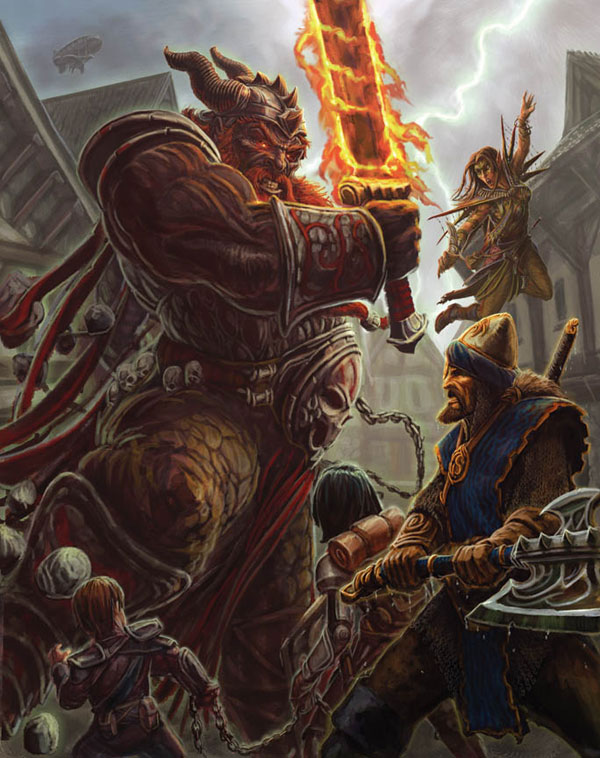
Thoughts so far: This is a very informative and useful chapter which helps set the mood for Ptolus. It is quite wordy in places, detailing things down to common street names and the typical materials of common buildings (which I skipped), but overall I liked it. My favorite parts were its means of information access, combining typical old-world style stuff (broadsheet newspapers, couriers) with more fantastical aspects (magical birds and thoughtstones).
Next time, Chapter 8: the Docks!